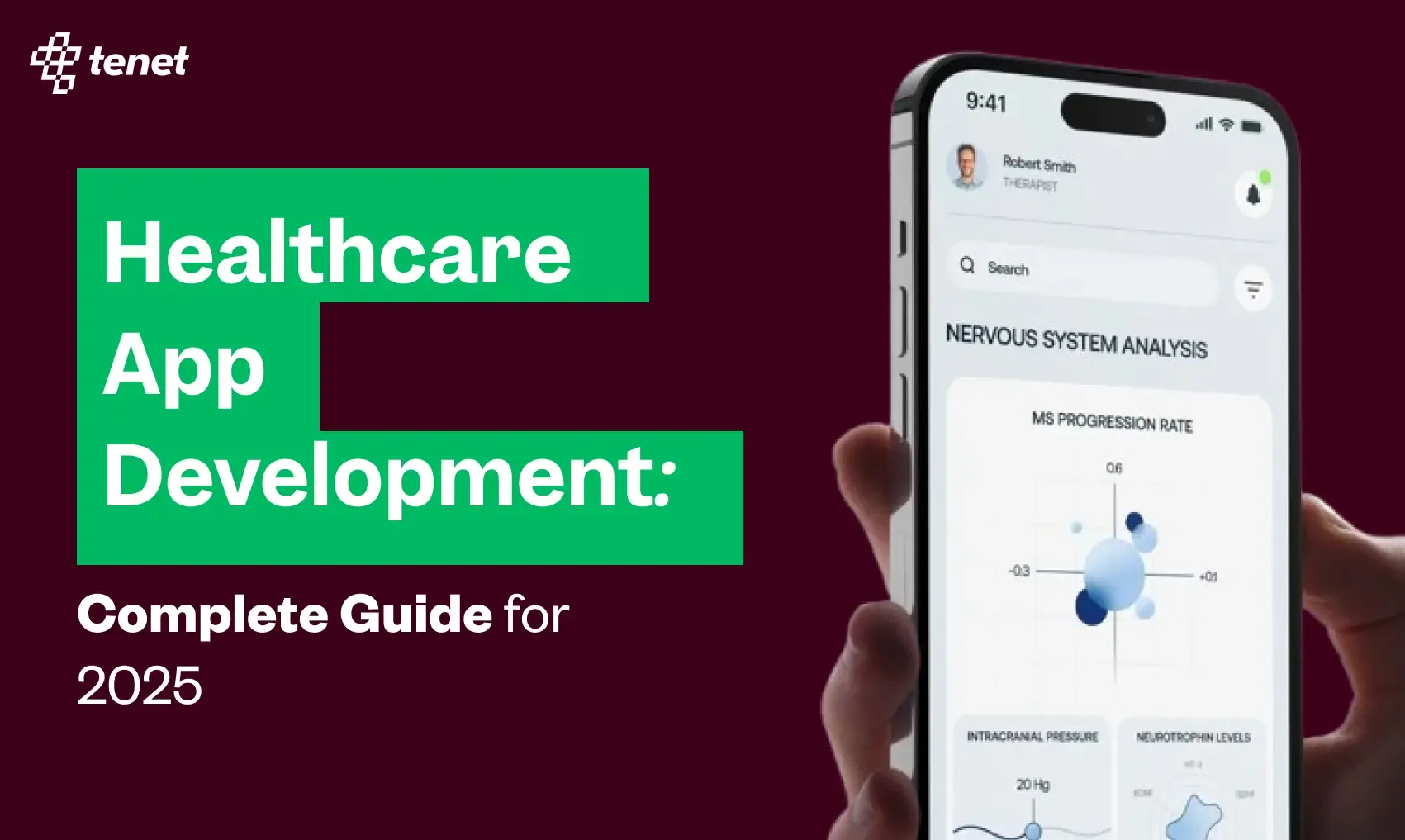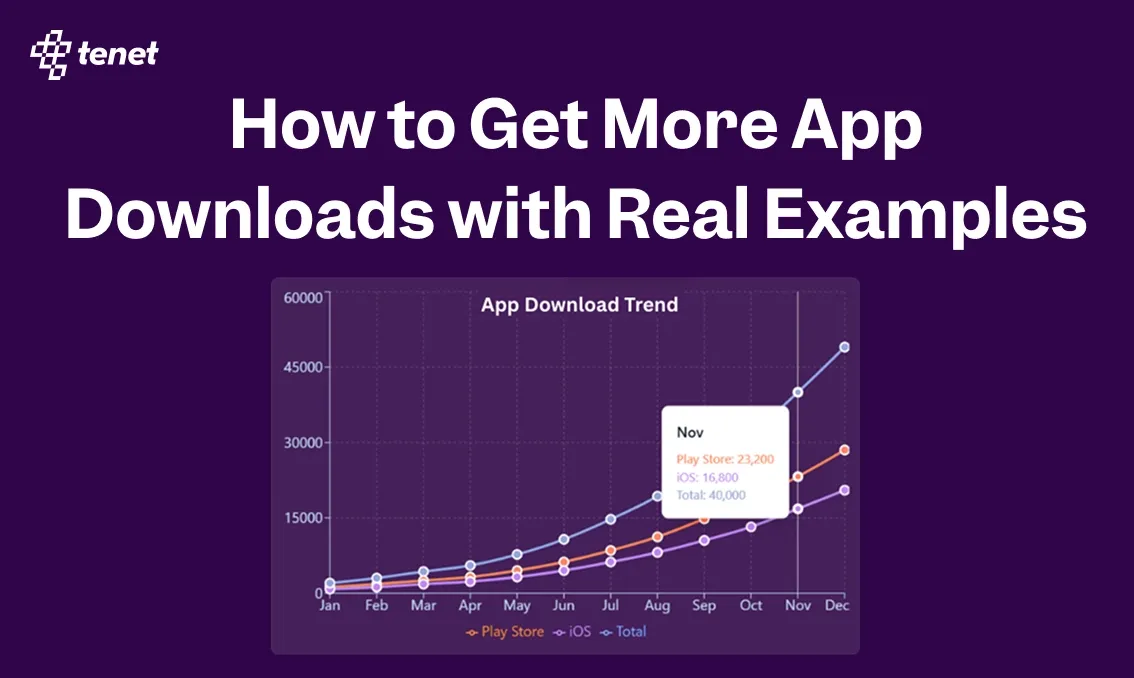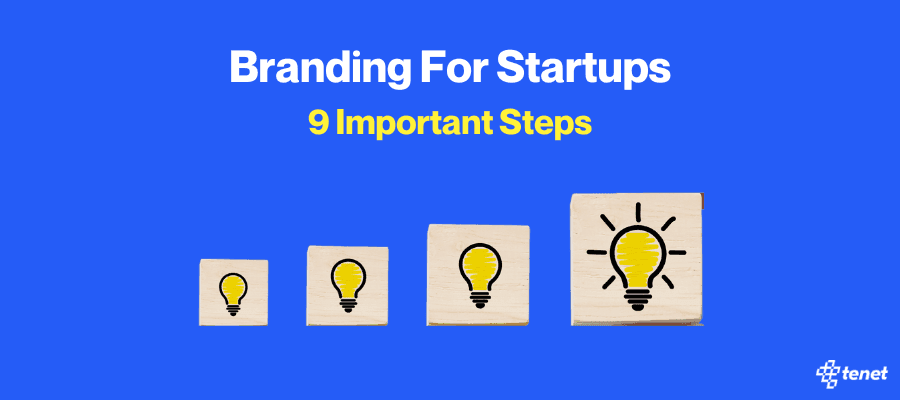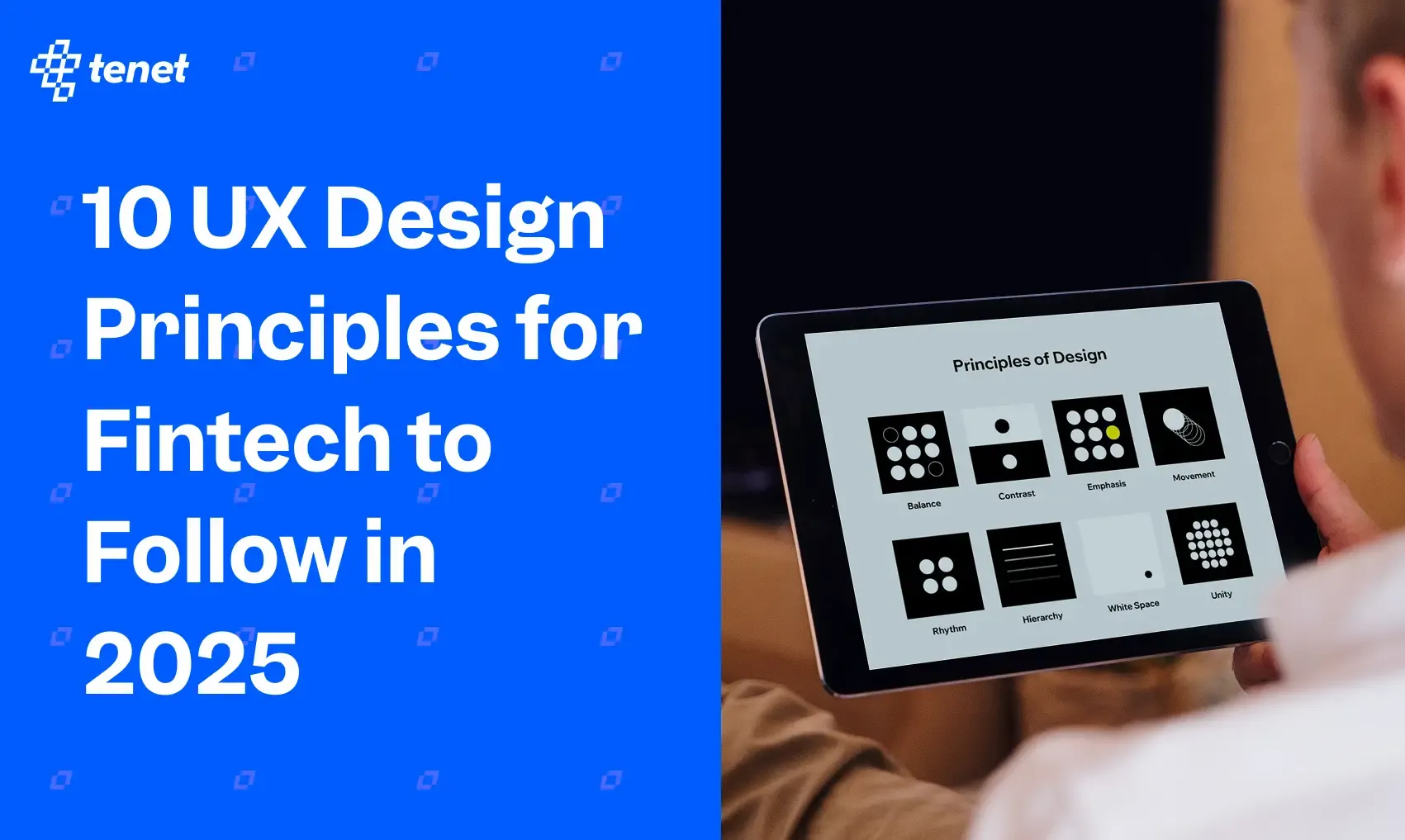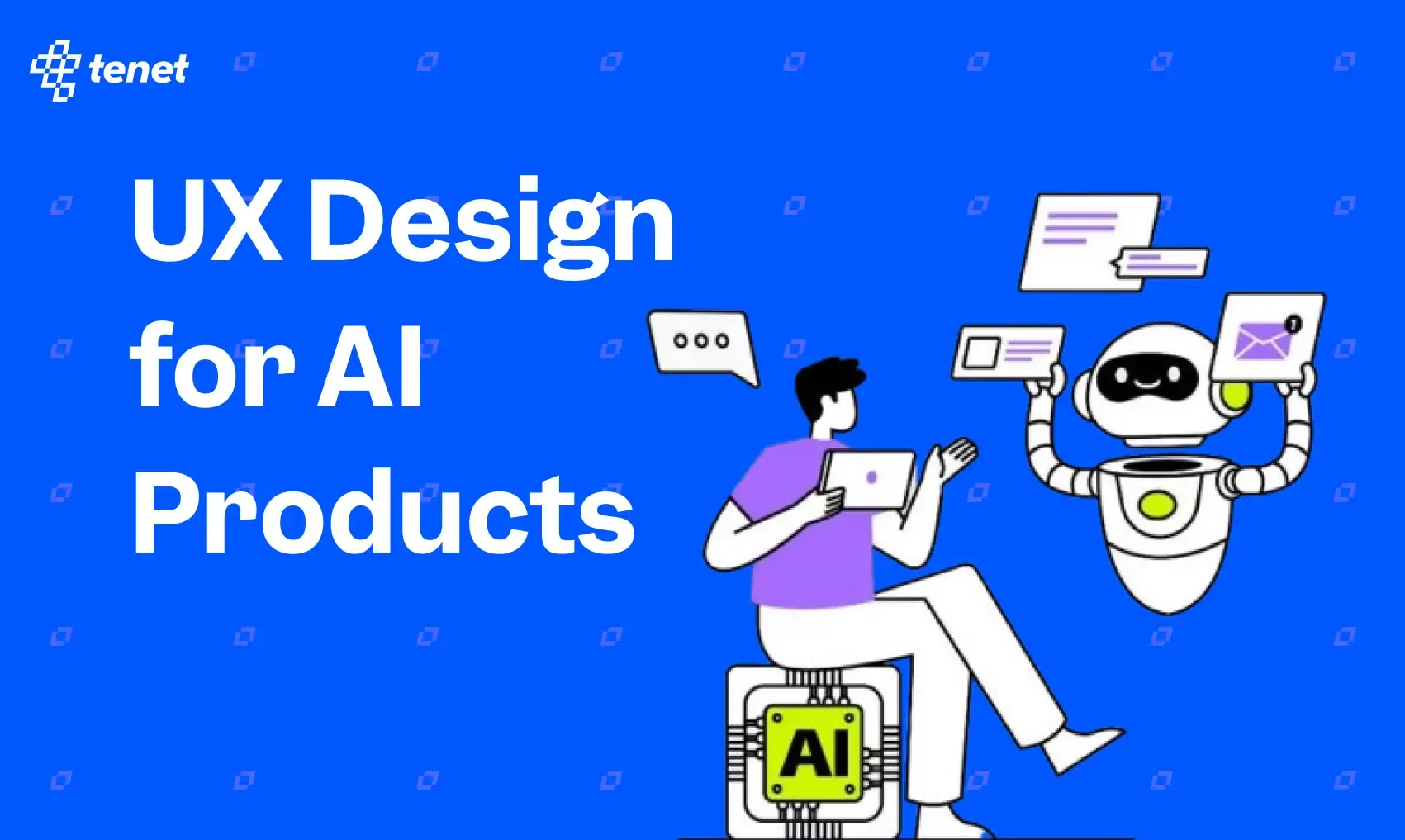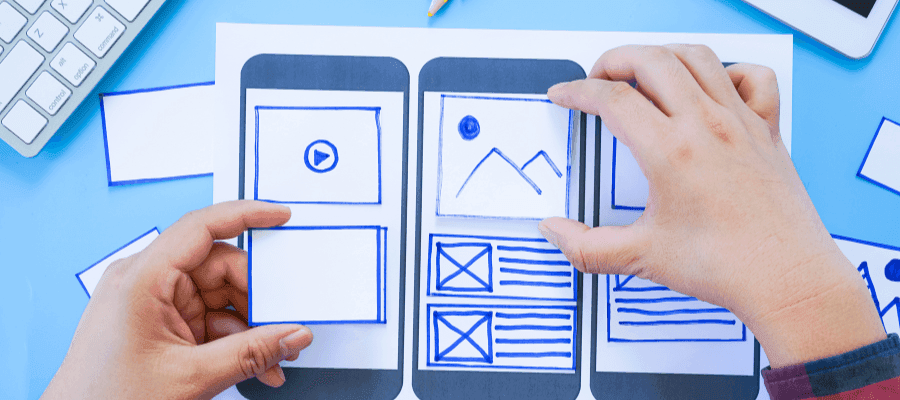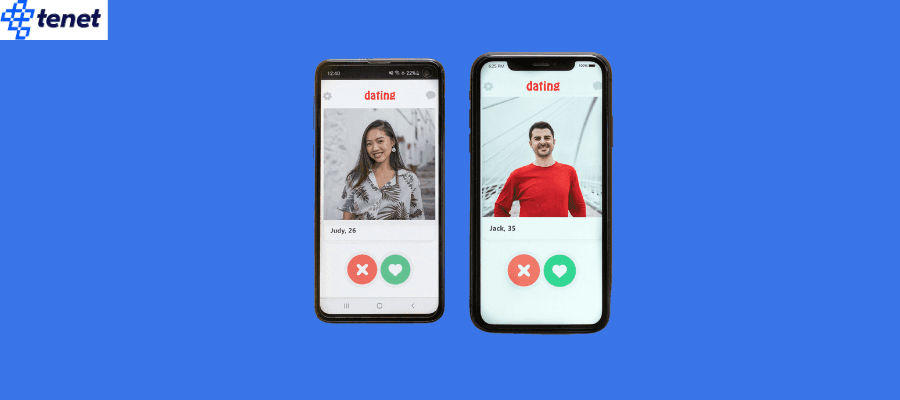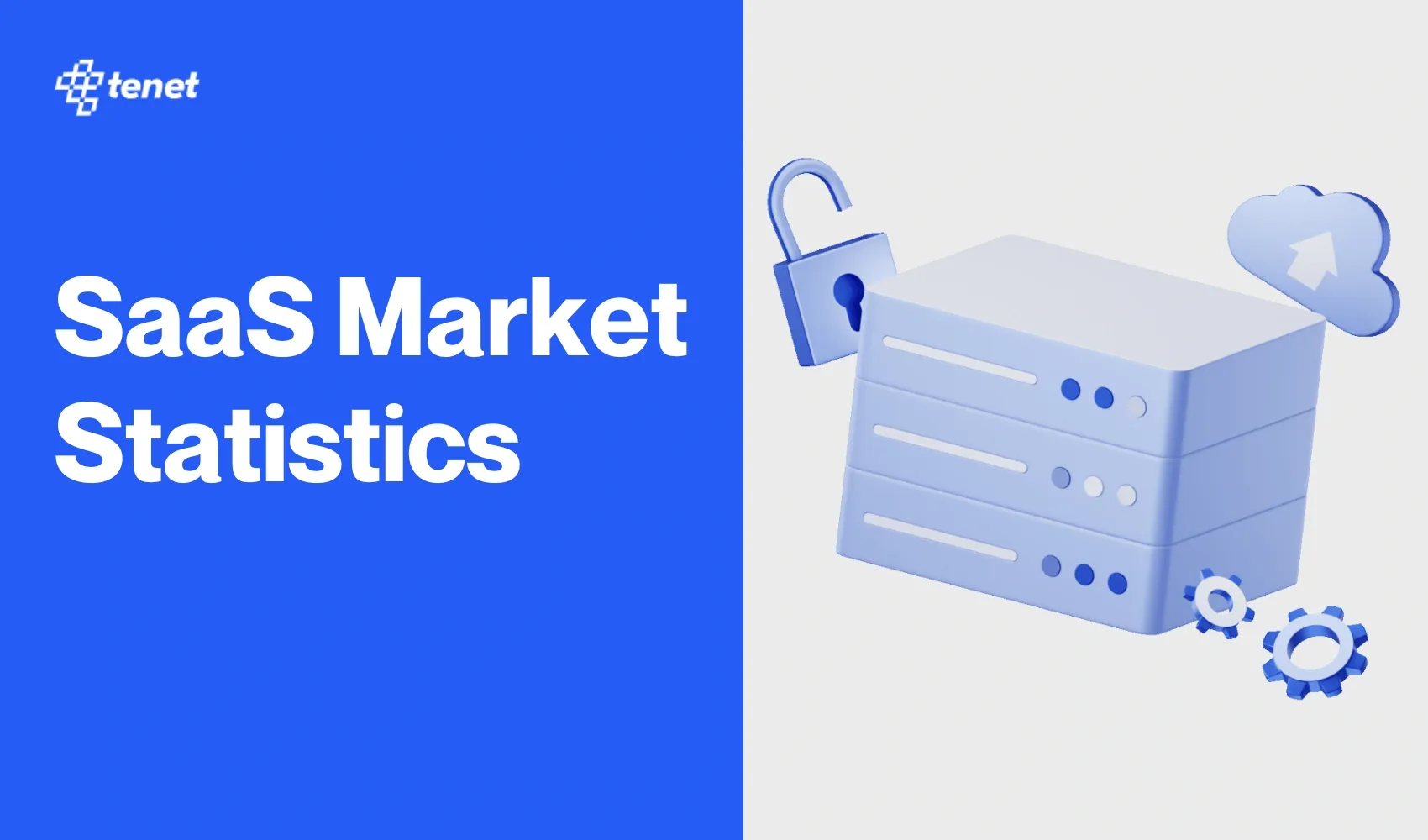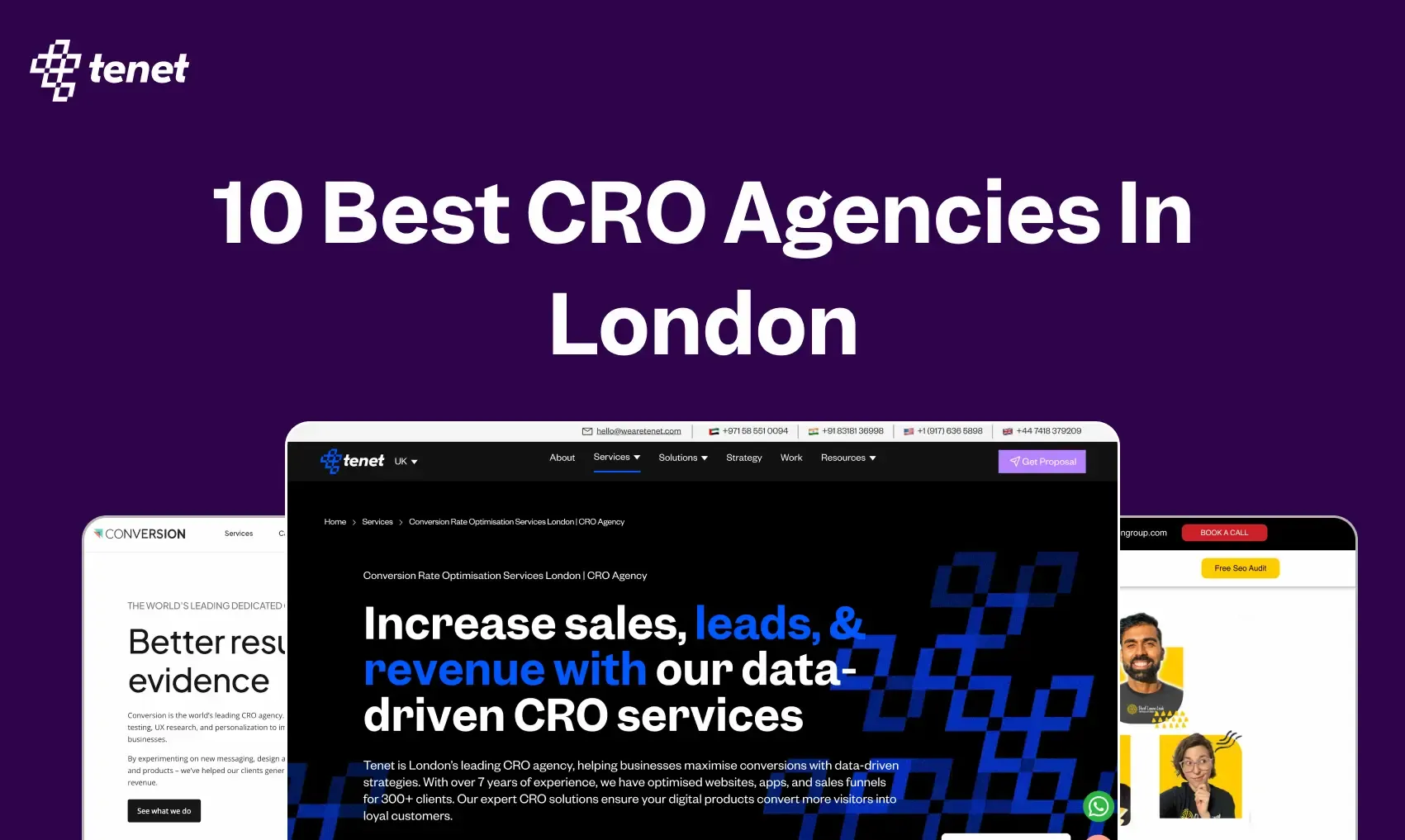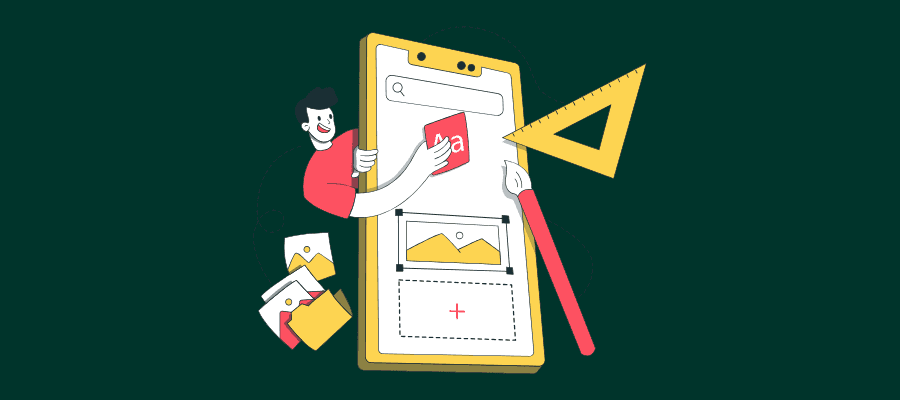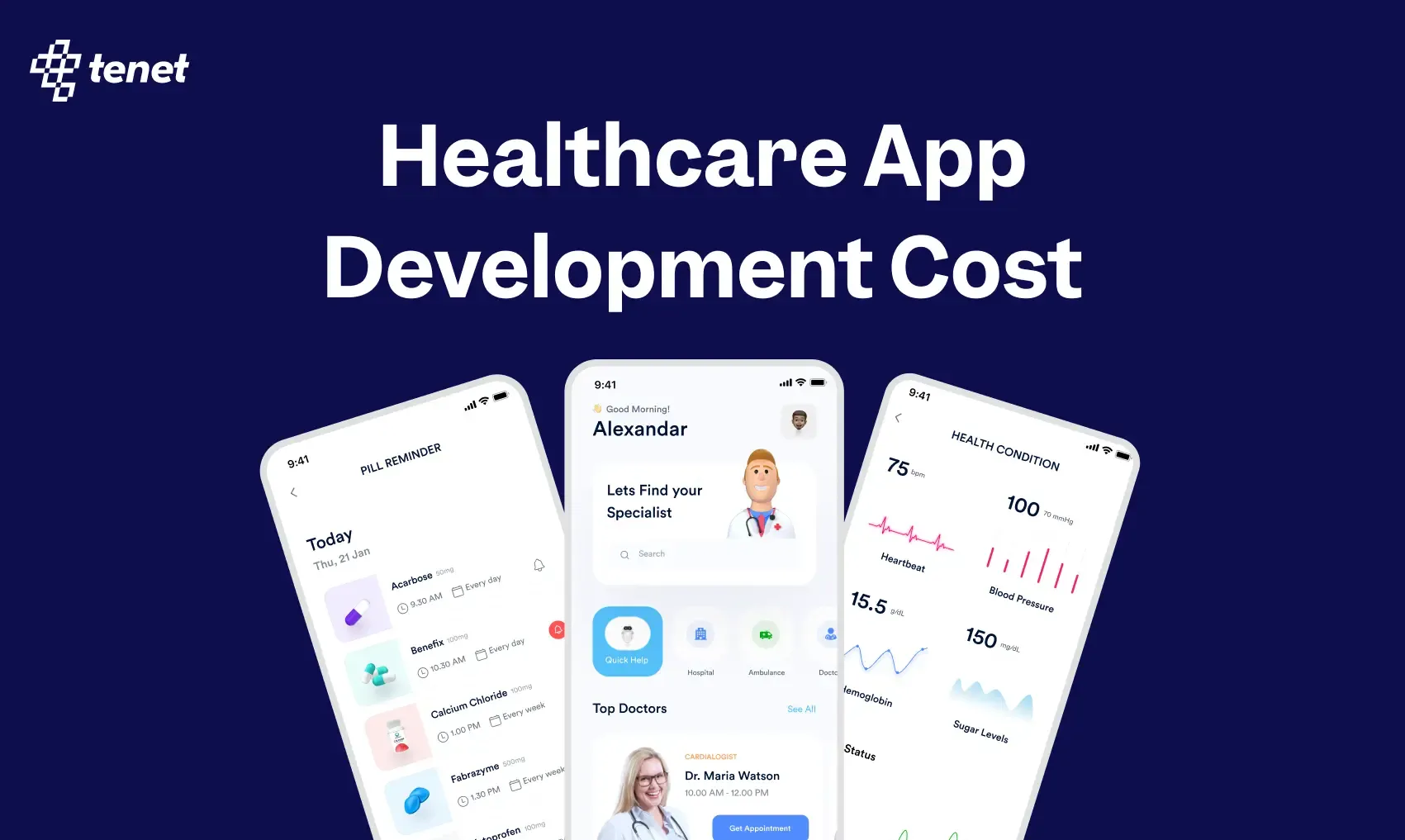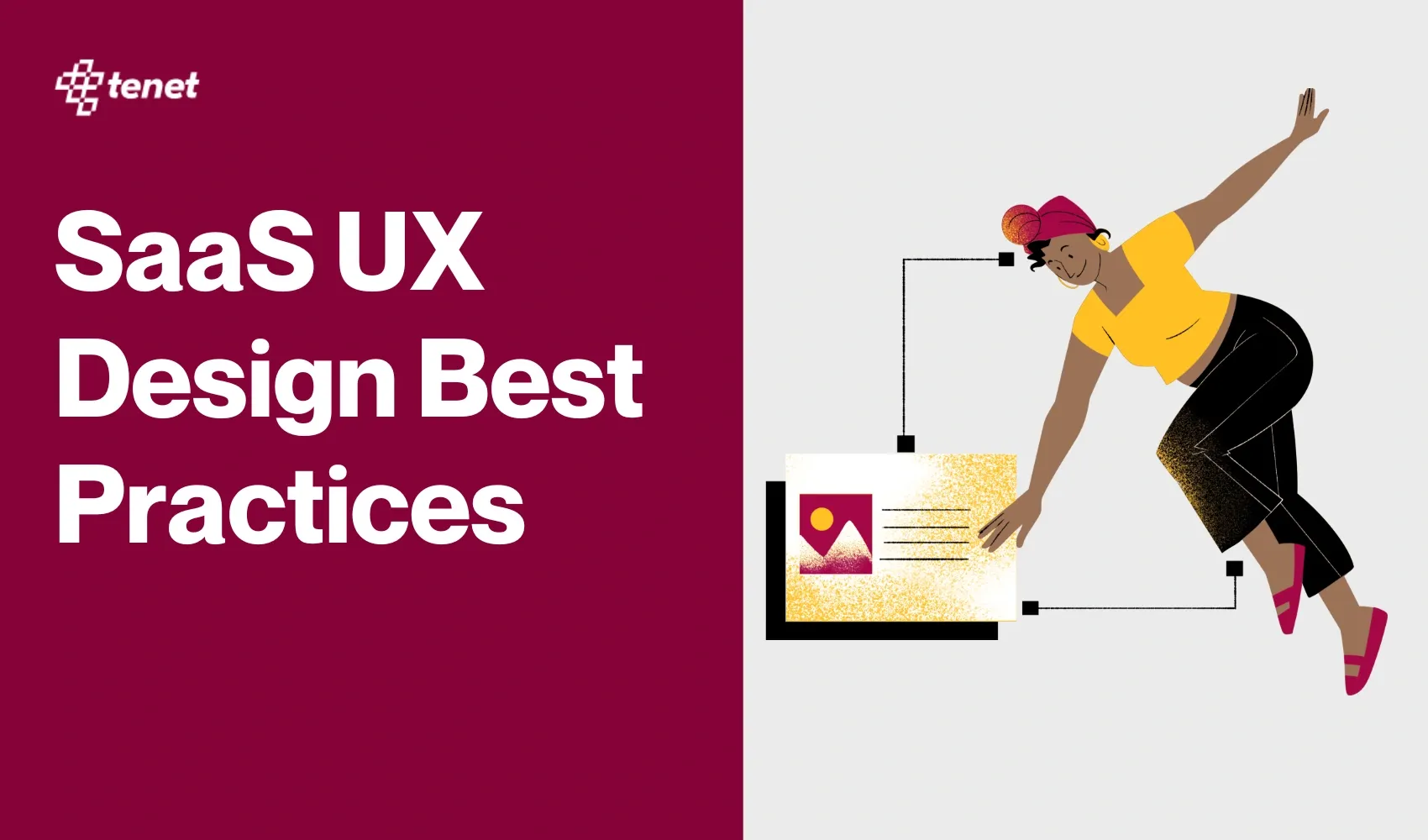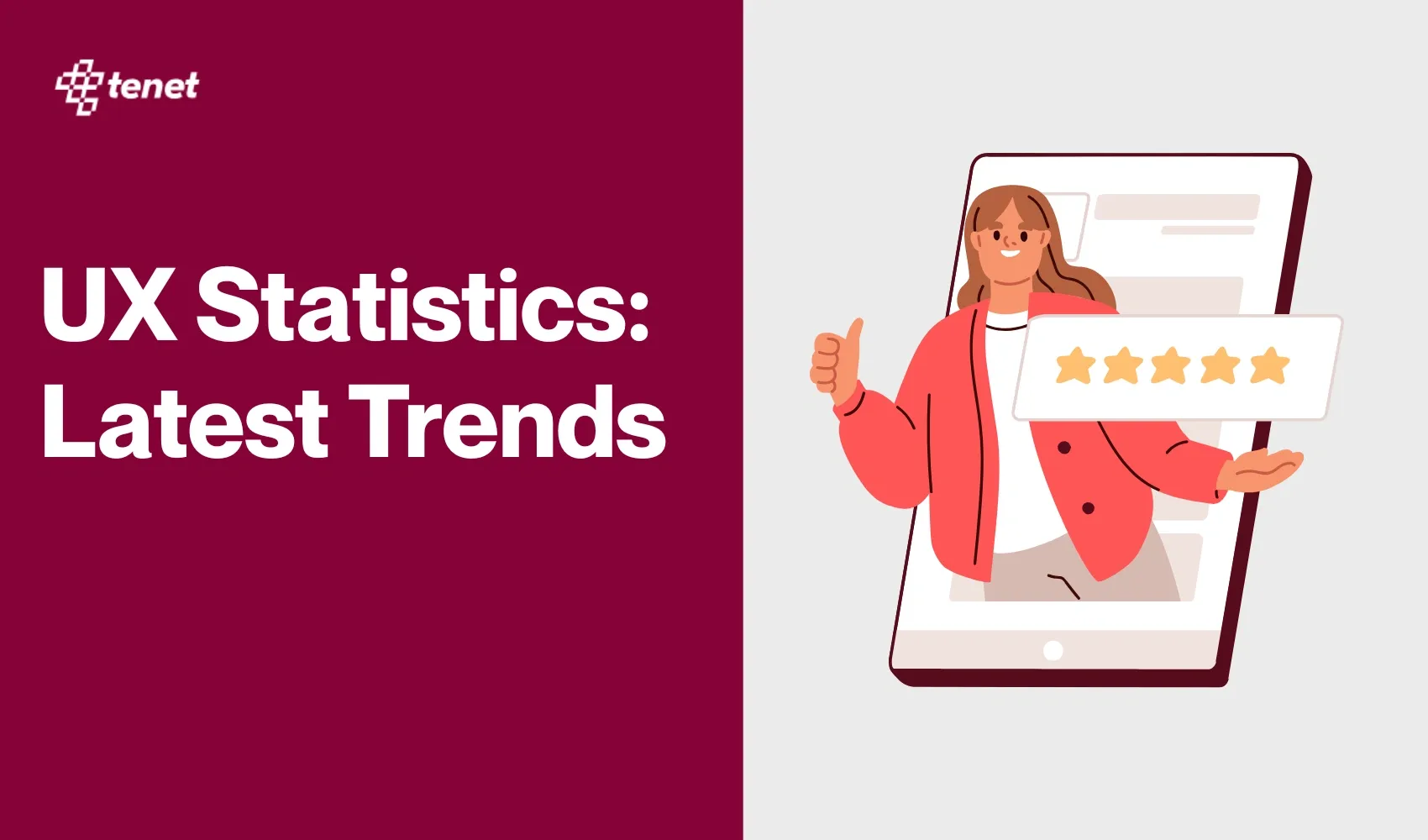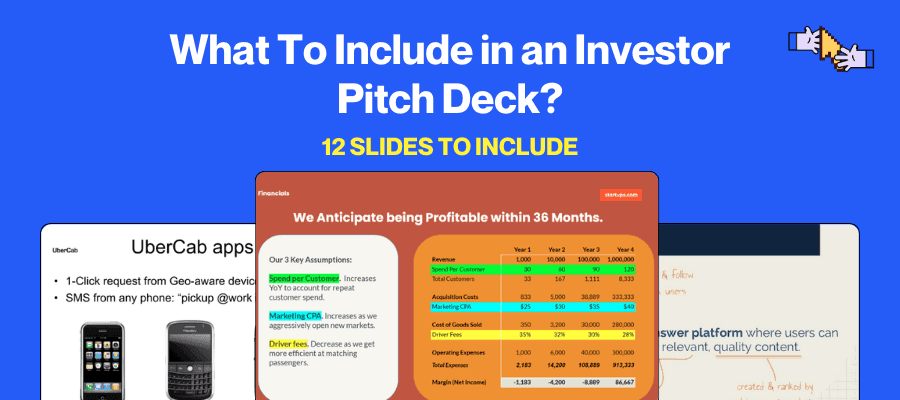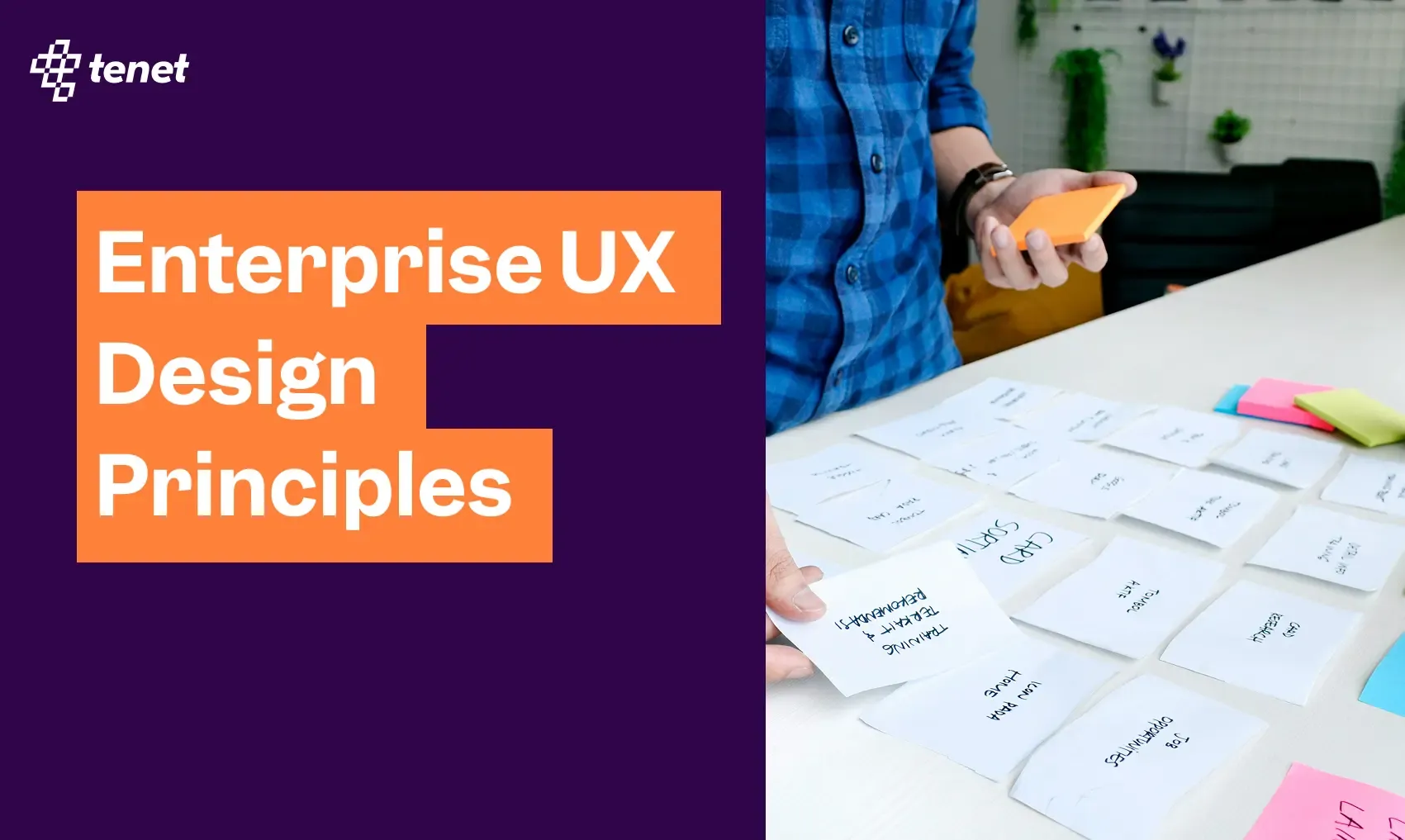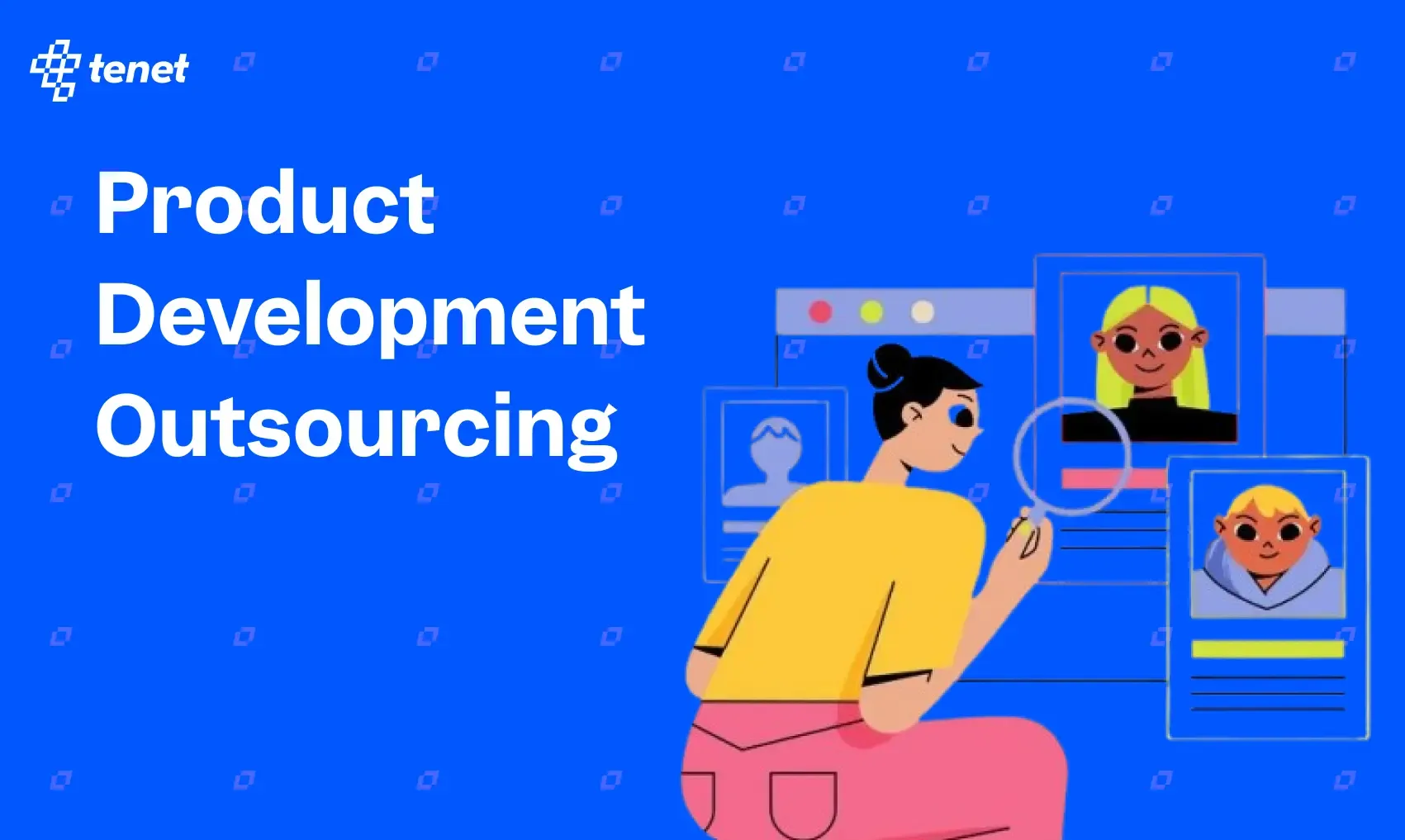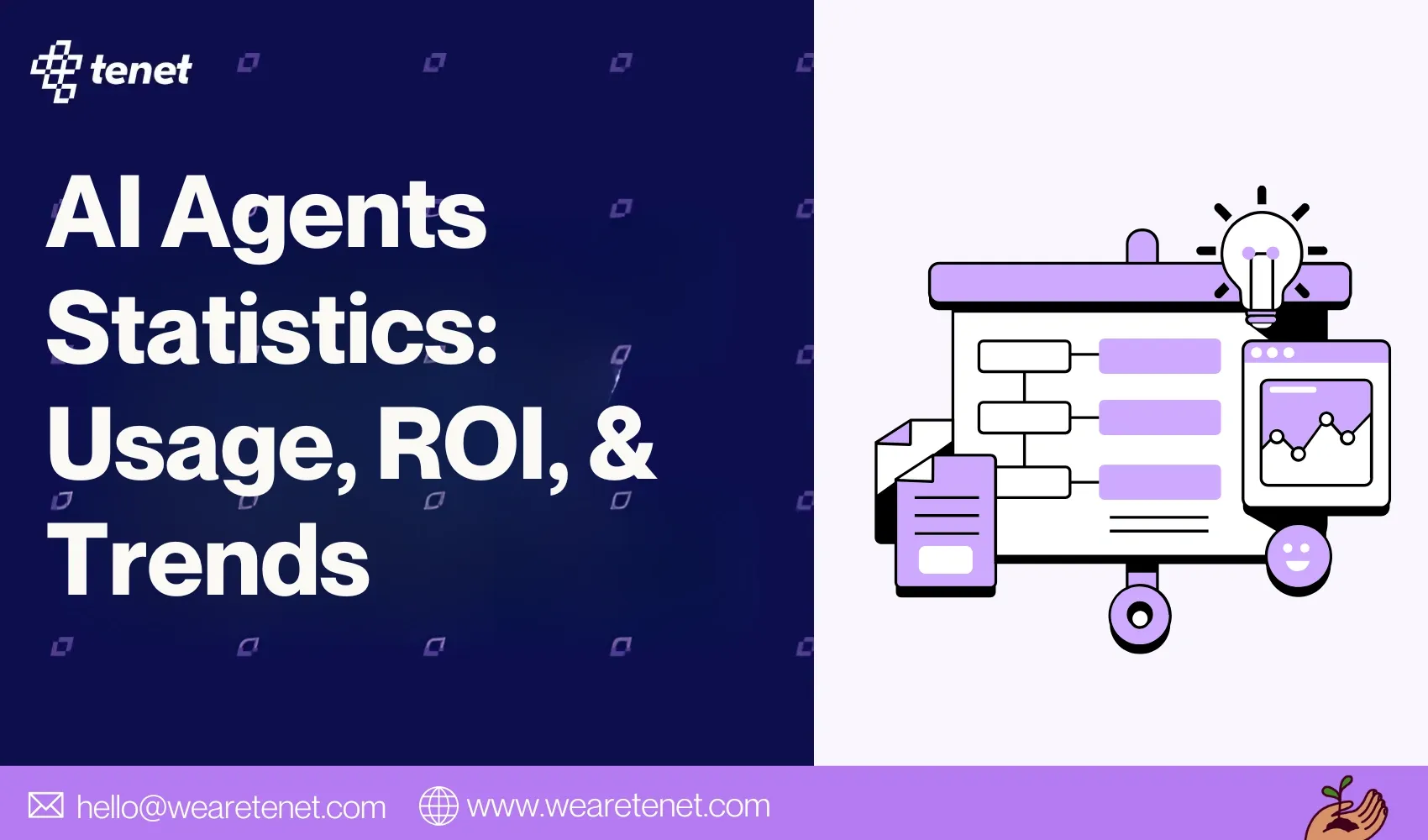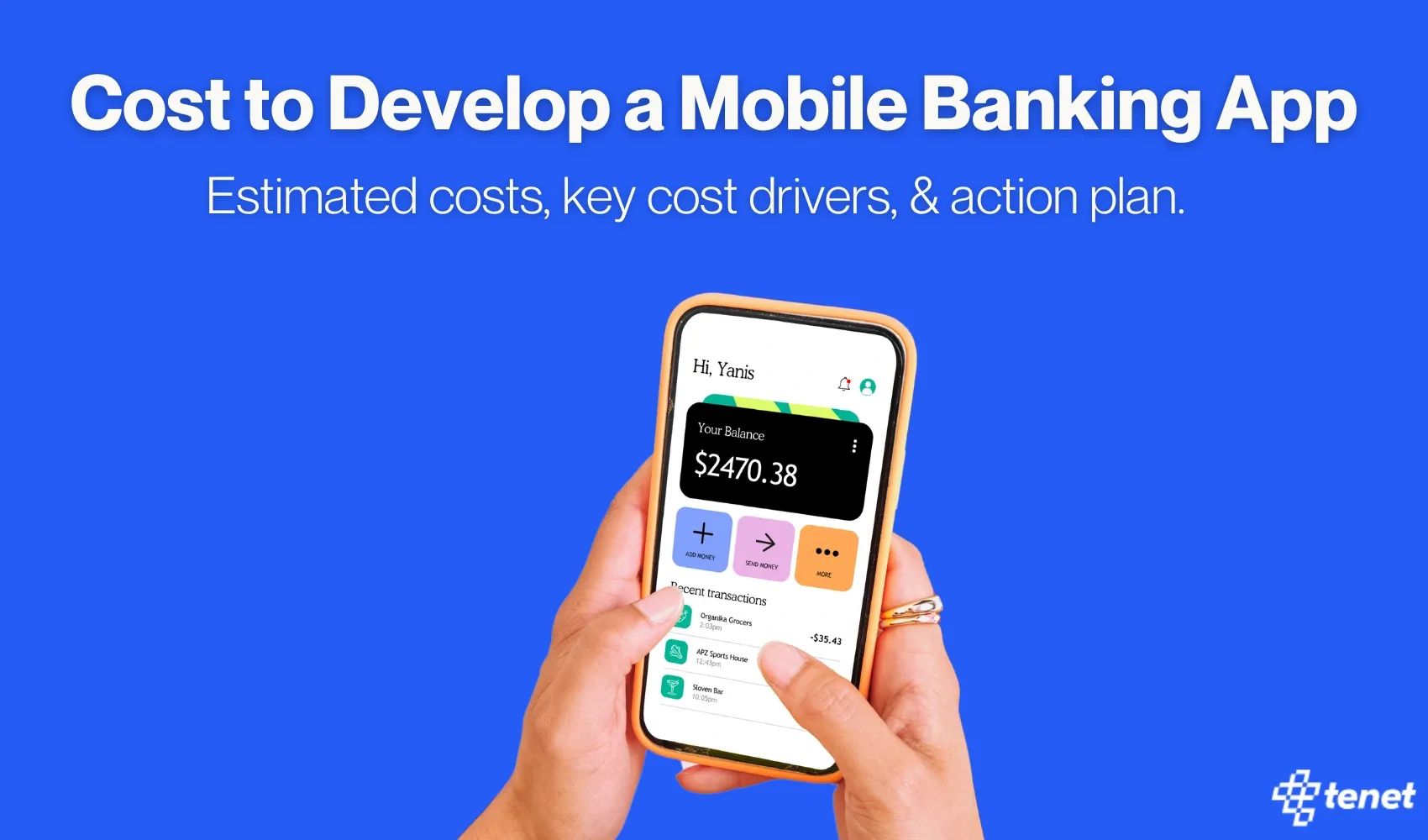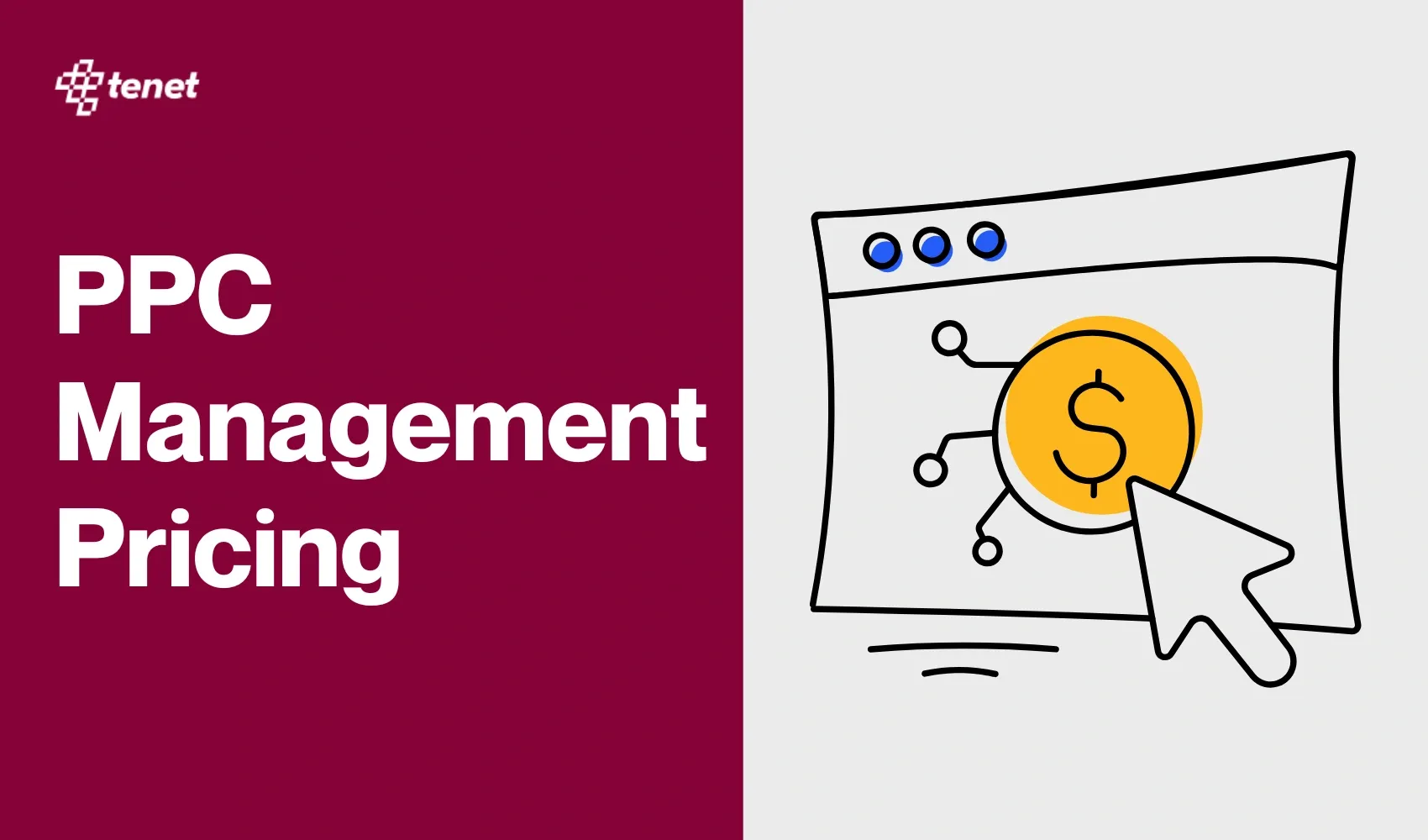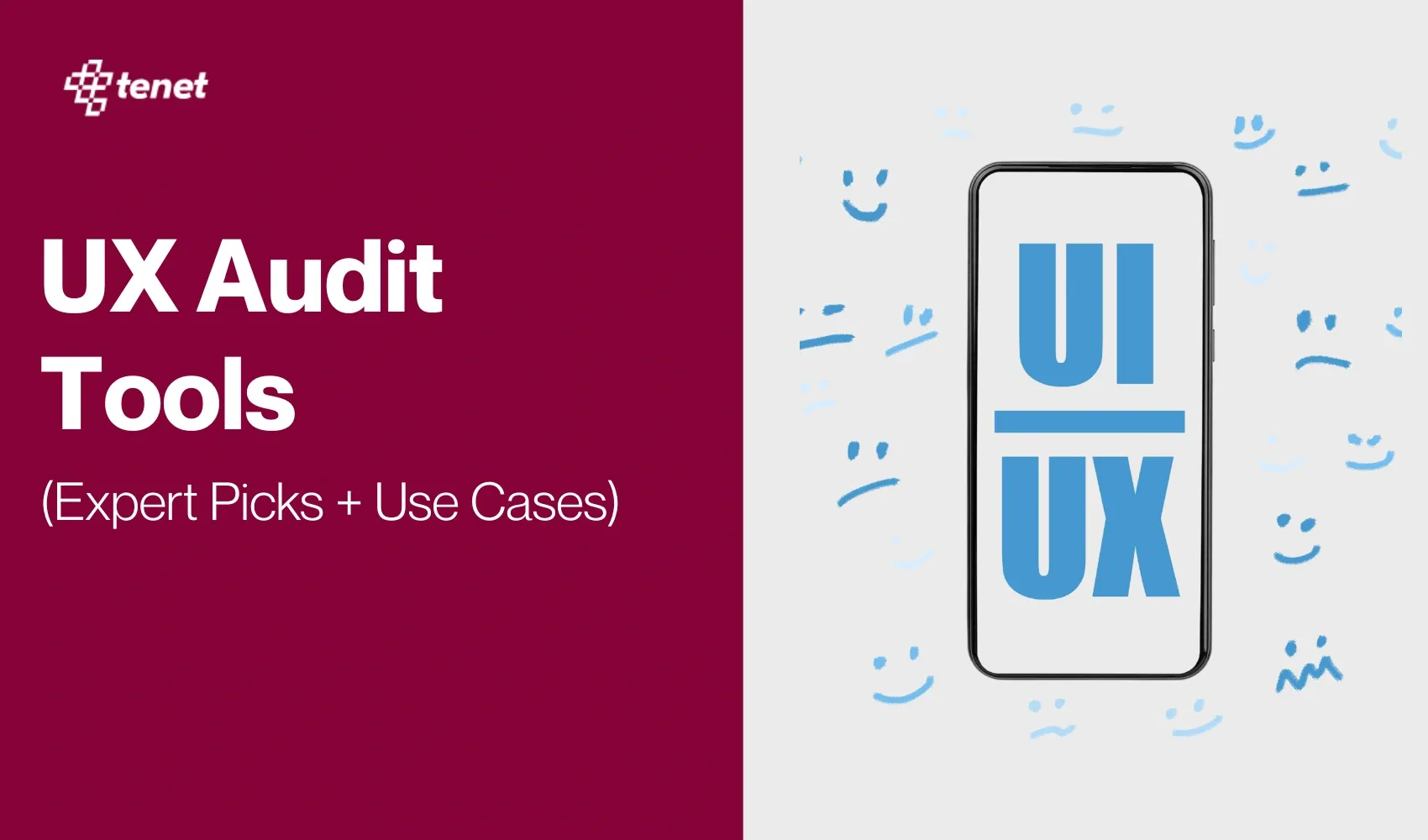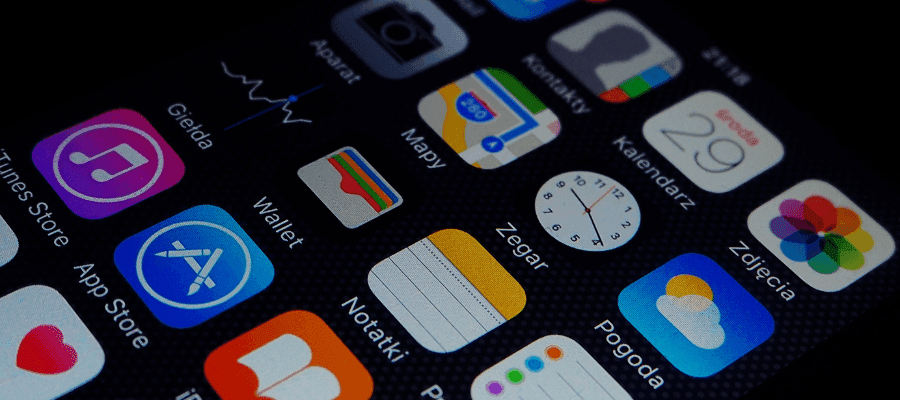Food Delivery App Development Cost In Dubai
Share
Share
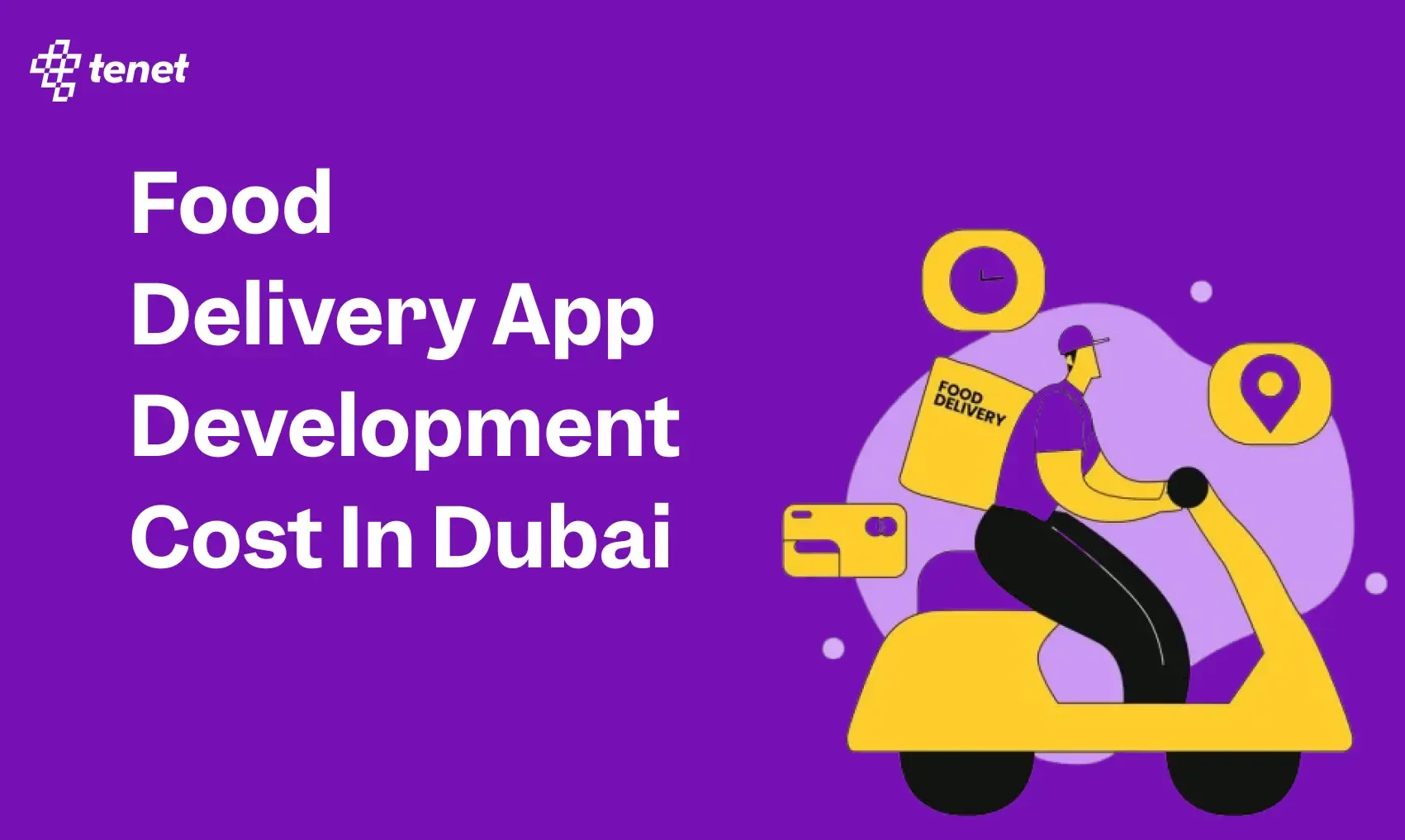
Developing a food delivery app in Dubai involves many cost factors—platform type, features, design, and compliance. Without expert planning, budgets can easily exceed expectations.
At Tenet, we’ve delivered over 450 mobile solutions across 15+ countries, including scalable apps for food tech startups.
This guide explains the actual cost of building food delivery apps like Talabat, Zomato, or Careem in 2025. Whether you need an MVP or a full-featured platform, use this breakdown to plan your investment with confidence.
What Is a Food Delivery App?
A food delivery app is a mobile application that makes ordering food easy and convenient. It allows users to browse nearby restaurants, check menus, place orders, make payments, and track deliveries, all from their smartphones.
Whether you're at home or work, you can get your favorite meals delivered in just a few taps. Popular apps like Talabat, Deliveroo, and Zomato have changed the way people in cities like Dubai enjoy food, offering speed, variety, and comfort at their fingertips.
👉 Here’s how Tenet can help you in your food delivery mobile app development:
- Develop your Android App with our experts
- iOS App Development Services
- Cross-Platform Mobile App Development
What are the key features of a Food Delivery App?
1. User Registration & Login
A seamless sign-up and login process helps users get started quickly and easily. Offer multiple options, such as phone OTP, email, social logins (Google, Apple), or biometric authentication. This reduces entry friction and increases conversions.
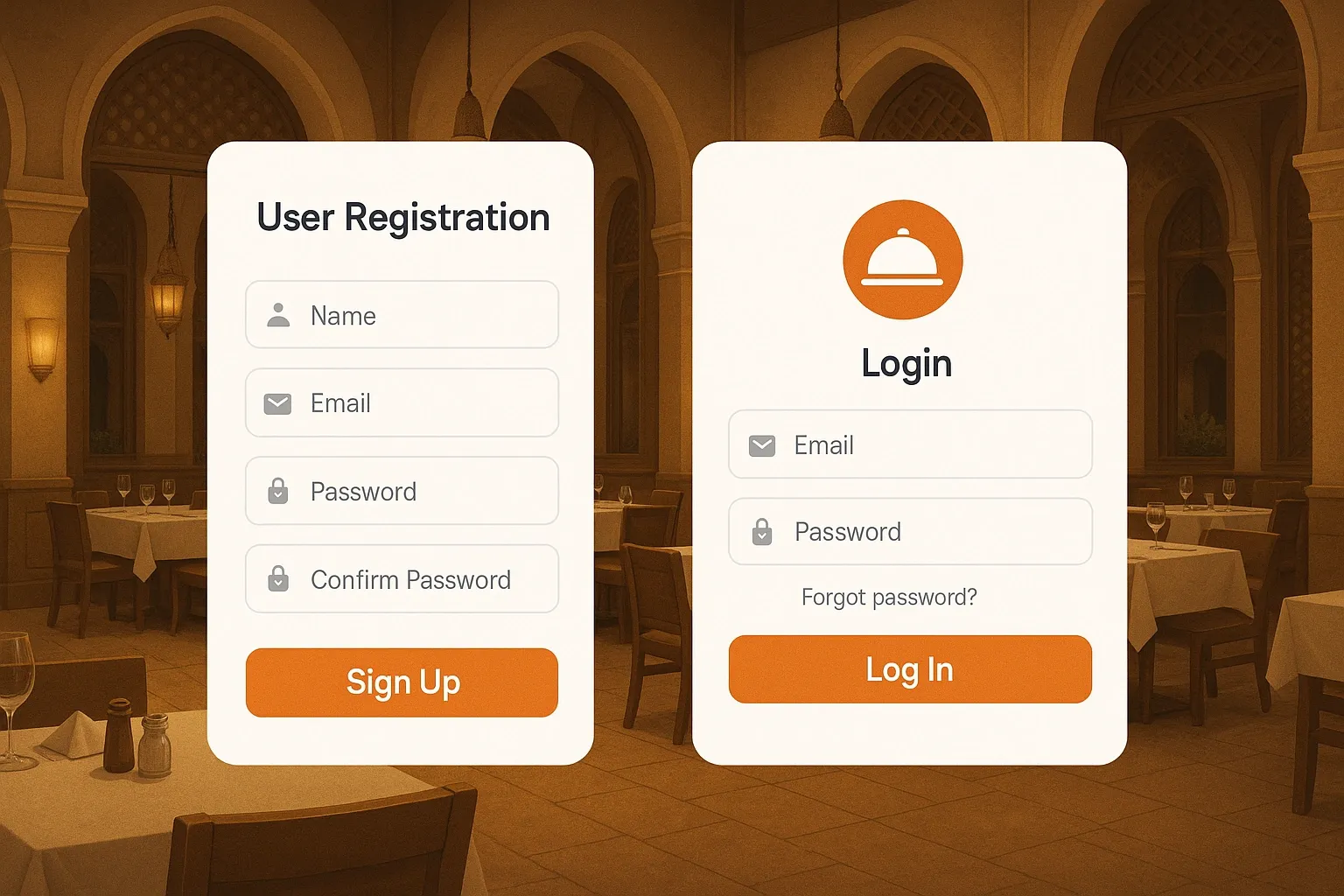
Dubai-based apps like Careem NOW integrate the UAE pass or national ID for added ease and trust. For long-term retention, support persistent sessions and quick re-login without password input, especially for mobile users.
2. Restaurant Listings
Restaurant discovery is the core of the user experience. Listings should display high-quality images, average ratings, delivery time, cuisine tags, pricing, and offers. The layout should adapt according to the user's location and preferences.
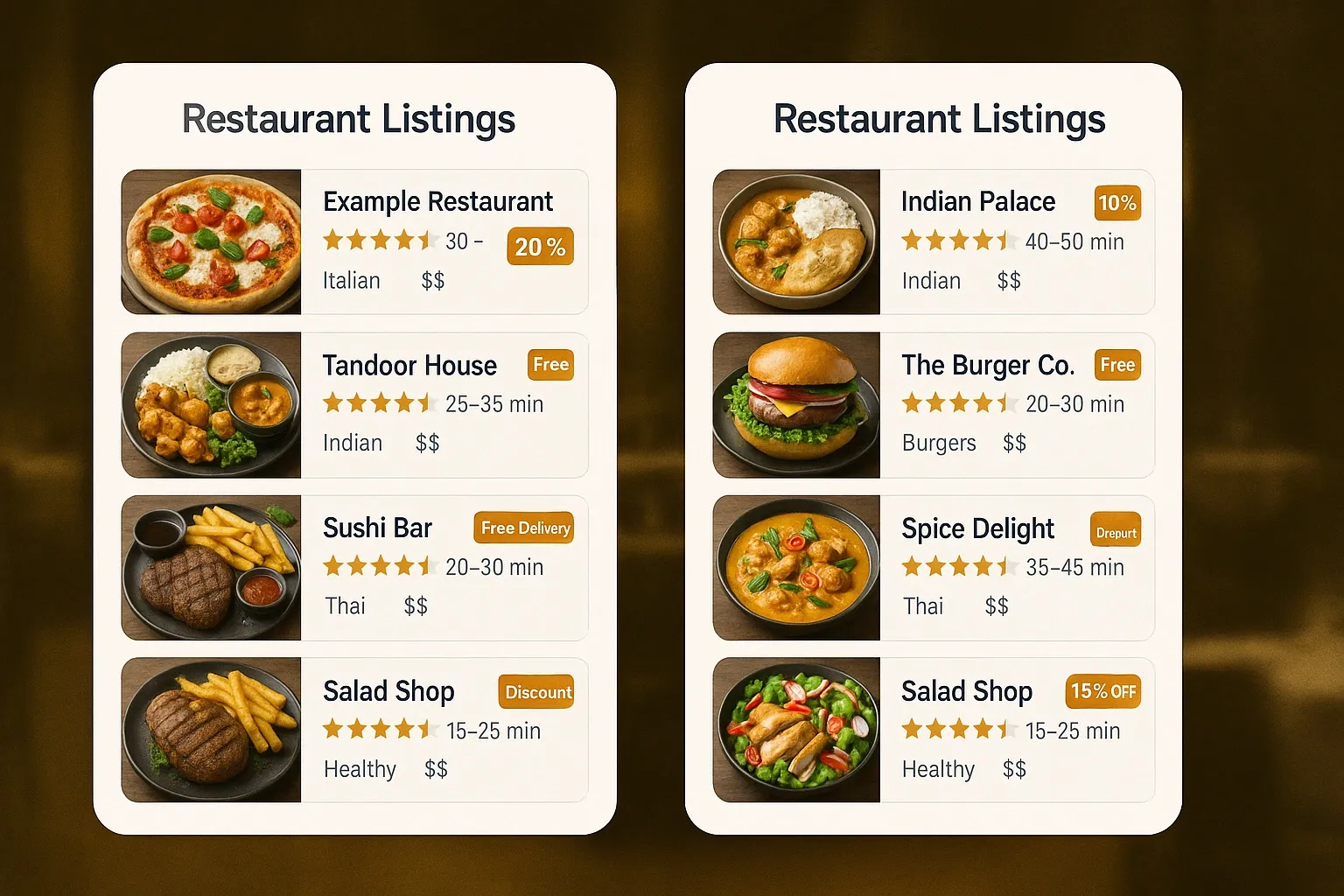
Apps like Talabat use heatmaps and popularity scores to float trending options. Smart sorting and filters enable users to quickly narrow down their choices, thereby improving engagement and reducing drop-offs in decision-making.
3. Real-Time Menu Browsing
Menus must load fast and reflect real-time availability. You can include options for item customization, add-ons, portion sizes, and special instructions. Deliveroo and Zomato display live menu syncing with restaurants' point-of-sale (POS) systems, ensuring items are always up to date.
Use icons for dietary tags, such as "vegan" or "halal," to enhance client understanding. Menu images, calories, and allergen info further enrich decision-making and create a polished ordering experience.
Here’s a sample design preview:
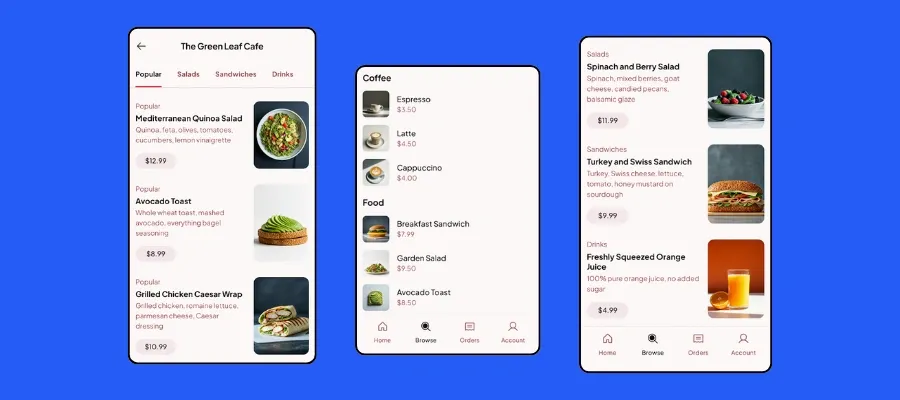
4. Smart Search & Filters
Powerful search functionality enables users to find what they need in seconds. Combine keyword search with filters for cuisine, delivery time, rating, diet preference, and budget. Incorporate voice search or auto-suggest features for quicker input. Zomato, for instance, offers search by dish name, not just restaurants. Machine learning can also surface personalized filter combinations based on past behavior.
5. Order Placement & Scheduling
The checkout flow must be smooth, with minimal steps and clear summaries. You can allow users to review their cart, edit customizations, add notes, and select a delivery time. Scheduled ordering is a popular option in Dubai, particularly for group lunches or corporate events.
The app must ensure transparent breakdowns for taxes, delivery fees, discounts, and tips. Auto-filled address from GPS or past orders speeds up the process.
6. Multi-Payment Integration
Offer a diverse range of secure payment methods to suit all user preferences. You can include debit/credit cards, Apple Pay, Google Pay, cash on delivery, and UAE-specific wallets like Payit or STC Pay.
The app must allow storing cards for repeat users in a PCI-compliant manner. For group orders or shared meals, enable split payment to facilitate easy payment distribution. Some apps even offer “pay later” features or loyalty wallet credits to drive frequency.
7. Real-Time Order Tracking
Live order tracking builds transparency and reduces user anxiety. Users can watch the progress: order accepted → food being prepared → picked up → en route → delivered.
The app displays real-time GPS tracking on a map, along with an estimated delivery time. Add dynamic updates for delays or rider reassignment. Riders should also receive optimized navigation, reducing delivery errors and late arrivals.
8. Push Notifications & Alerts
Push alerts keep users informed and engaged throughout the journey. Notify them about order status changes, delivery delays, discounts, or app updates.
Dubai apps like Talabat personalize notifications around mealtimes or offer expiry dates. You can allow users to control their notification preferences directly from the app settings. Rich notifications (with images or buttons) can even drive one-tap reorders or quick reviews.
9. In-App Chat or Call Support
Communication is key to resolving real-time issues. You can enable users to chat with support agents, delivery partners, or restaurants within the app. Include predefined responses and attachments (such as location pin sharing).
Many Dubai-based apps also offer voice support via VoIP integration. Quick access to help improves satisfaction and reduces churn during critical ordering moments.
10. Ratings, Reviews & Feedback
Post-delivery reviews create accountability and help future users. Enable customers to rate food, delivery experience, and service separately. Collecting detailed feedback allows better quality control.
You can display top reviews or photo-based ratings prominently on restaurant pages. Some apps reward users with loyalty points for sharing helpful feedback. Analyzing these reviews also helps in restaurant curation and removing underperformers.
11. Loyalty Programs & Coupons
Encourage frequent orders by integrating rewards and coupons. You can offer promo codes, referral bonuses, and cash back on select restaurants. Talabat Pro in Dubai offers a free subscription with exclusive delivery benefits and deals.
Gamified loyalty systems, such as badges or tier levels, motivate users to engage more actively with the app. You can ensure personalized offers based on order history, geography, or time of day to achieve a better return on investment (ROI).
12. Admin & Vendor Dashboards
Restaurants and platform admins need control panels to manage operations. A vendor dashboard should enable real-time order acceptance, menu updates, price adjustments, and promotions.
Admins can monitor analytics, compliance, customer behavior, and system performance. Build dashboards with clear charts and metrics, such as delivery time, rating trends, peak hours, and top items, to inform business decisions.
13. Delivery Agent App
Delivery personnel need a separate app to manage routes, pickups, deliveries, and support. Show real-time order queue, delivery location, customer contact, and payment method.
You can include availability toggles, navigation via Google Maps, and performance tracking (e.g., delivery time, ratings). In Dubai, apps like Deliveroo also include earnings summaries and incentives for better productivity.
14. Geo-Fencing & Location Accuracy
Location-based features optimize delivery logistics and marketing. Geo-fencing allows push deals based on zones (e.g., free delivery in Business Bay). Accurately detecting user location helps assign nearby drivers and avoid failed deliveries. Ensure your app utilizes GPS, IP data, and address history in conjunction for enhanced precision. Geo-fencing also supports hyperlocal restaurant discovery.
15. Cloud Kitchen Integration
Cloud kitchens are on the rise in Dubai, allowing multiple virtual brands to operate from a single location. Your app should support backend tools to handle different menus, brand identities, and routing for such kitchens. You can provide delivery status tracking, inventory sync, and individual reporting per brand. Cloud kitchen integrations are crucial for scaling rapidly without requiring physical space expansion.
16. AI-Powered Personalization
Leverage AI to personalize user journeys. Suggest dishes based on past orders, location, time of day, and dietary preferences. Predictive search, reorder buttons, and curated home screens drive better engagement. Apps like Deliveroo utilize machine learning (ML) algorithms to surface trending combinations or repeat favorites, thereby improving both the customer experience and cart size.
17. Performance & Scalability (Tech Stack)
The app must scale effectively during lunch rushes and weekend surges. You can utilize scalable cloud infrastructure (such as AWS or GCP), content delivery networks (CDNs) for rapid content loading, and a microservices architecture.
Backend frameworks, such as Node.js or Django, and frontend tools, like React Native or Flutter, enable faster updates and cross-platform compatibility. Proper load balancing and caching reduce downtime.
18. Data Security & GDPR Compliance
Handling sensitive user data, such as addresses and payment details, requires top-notch security. You can use end-to-end encryption, secure APIs, and two-factor authentication for critical actions. Compliance with local laws (UAE’s PDPL) and international standards (GDPR, PCI-DSS) builds trust. Regular audits and penetration testing ensure that your food delivery app is safe and reliable.
19. Analytics & Reporting Tools
Built-in analytics give restaurants and admins a performance edge. You can provide dashboards that display order volumes, average delivery times, cancellation rates, popular dishes, and customer retention statistics.
These reports enable restaurants to understand peak hours, identify top customers, and emotional changes fortheir promotions. Utilise data insights to refine algorithms, update menus, or run targeted campaigns.
20. Multilingual Interface
Dubai’s multicultural population makes multilingual support essential. It offers seamless language toggling (e.g., English and Arabic) and right-to-left (RTL) compatibility. You must ensure the content is well-translated, not just word-for-word, but culturally relevant.
The app can include the option to remember a user’s language preference. This widens accessibility and enhances the user experience across segments, including tourists, expatriates, and locals.
Unique Add-On Features to Consider
- Reorder Reminder Notifications – Suggest past orders automatically at similar times.
- Dark Mode UI – For users who work late at night or are visually sensitive.
- Smartwatch Compatibility – Enable status updates on wearable devices.
- Voice-Activated Ordering – Useful for accessibility and speed.
- Eco Packaging Toggle – Let users request plastic-free delivery.
- Health & Calorie Filters – Show meals by calorie or diet type.
- Surge-Aware ETA Adjuster – Adjust delivery promises during peak hours.
- Gift a Meal – Send food to friends with messages or wrapping options.
- Personal Spending Tracker – Let users see their food spending over time.
- Downloadable Invoices – Auto-create tax/GST-compliant receipts for business meals.
What Impacts Food Delivery App Development Cost in Dubai?
1. App Complexity and Feature Set
The more features your app includes, such as real-time order tracking, in-app chat, AI-driven recommendations, or loyalty programs, the higher the cost. A simple MVP with core ordering and payment can be built affordably, but advanced functionality requires custom logic, backend support, and more development time. Apps that aim to compete with Talabat or Deliveroo need premium features to stand out.
Impact: More complex apps significantly increase development costs (positive impact on pricing).
2. Number of Platforms (iOS, Android, Web)
Building the app for multiple platforms multiplies the development effort. A native app for iOS and Android, as well as a web dashboard for vendors or admins, all require separate UI/UX considerations, testing, and maintenance. Cross-platform solutions like Flutter reduce costs slightly but might sacrifice native experience.
Impact: Supporting multiple platforms increases cost due to parallel development (positive impact on pricing).
3. Design Customization and UX Depth
Custom branding, interactive UI elements, RTL Arabic support, and unique user journeys raise design and front-end development time. Dubai’s competitive market demands a polished, responsive, and accessible user experience (UX) for both English and Arabic speakers. Using templates can reduce cost, but it limits user experience and brand differentiation.
Impact: Advanced, multilingual, and branded designs increase cost (positive impact on pricing).
4. Real-Time Features (GPS, Notifications, Chat)
Features like live GPS tracking, instant order status updates, in-app support chat, and real-time delivery assignment require socket programming and low-latency backends. These increase technical complexity and server costs but are essential for user trust and seamless experience in Dubai’s fast-paced environment.
Impact: Real-time capabilities significantly raise backend development costs (positive impact on pricing).
5. Third-Party Integrations
Integrating payment gateways, logistics APIs, marketing tools, and analytics platforms requires additional setup, testing, and sometimes licensing fees. In Dubai, integrating with UAE-specific tools like Payit or Noon Payments also adds complexity. Each integration point is a potential cost and risk multiplier.
Impact: More integrations mean more effort, which increases the total app cost (resulting in a positive impact on pricing).
6. Team Location and Experience
Hiring a Dubai-based or highly experienced team ensures faster delivery, better compliance, and region-specific user experience (UX). However, this comes at a premium. Offshore teams in India or Eastern Europe can cut costs, but may lack contextual understanding or real-time collaboration.
Impact: Local, experienced teams charge more, resulting in an overall increase in cost (positive impact on pricing).
7. Compliance and Data Security
Adhering to the UAE’s PDPL, GDPR, and PCI-DSS standards involves encryption, secure APIs, and legal support. Apps handling personal data and payments must protect user privacy, which adds extra layers to development and infrastructure setup, especially if cloud data localization is required.
Impact: Security and compliance requirements add to cost but are mandatory (positive impact on pricing).
8. Admin Panel & Restaurant Dashboard
Building a dynamic admin panel and restaurant dashboard for order tracking, menu updates, analytics, and issue resolution requires a robust backend and an intuitive user interface. This is essential for managing high-order volumes and vendor coordination, but adds separate development cycles.
Impact: Admin tools increase backend workload and UI scope (positive impact on pricing).
10. Delivery Agent App & Routing Logic
If you plan to manage your fleet, a rider app is essential for effective fleet management. It includes features like order queue, route optimization, shift toggling, earnings tracking, and delivery verification. Route logic development is complex and essential for efficiency, adding a separate codebase.
Impact: Building a rider app adds to the total cost due to distinct feature needs (positive impact on pricing).
11. Cloud Infrastructure and Scalability
Scalable hosting (e.g., AWS, Azure) with auto-scaling, content delivery networks (CDNs), and real-time load management ensures optimal performance during peak times. While this offers reliability and future-proofing, setup and recurring infrastructure costs are higher than basic shared hosting solutions.
Impact: Scalable cloud infrastructure increases upfront and ongoing costs (positive impact on pricing).
12. Multilingual Support (Arabic + English)
Supporting Arabic and English requires dual content management, testing in both left-to-right (LTR) and right-to-left (RTL) formats, and additional translation and localization effort. This is crucial in Dubai’s multilingual environment to ensure accessibility across user segments.
Impact: Multilingual support adds design and development effort (positive impact on pricing).
13. Post-Launch Maintenance & Updates
Ongoing costs include bug fixes, app store compliance, security patches, and feature updates. This is a long-term investment aimed at keeping the app stable and relevant. Ignoring maintenance risks, user drop-off, and system failure.
Impact: Regular maintenance adds ongoing cost, necessary for app longevity (positive impact on pricing).
How much does it cost to build a food delivery app in Dubai (2025)?
Overall Price Range: Developing a food delivery app in Dubai typically costs between $15,000 and $70,000+, depending on features, complexity, and development approach.
- Basic App (MVP): Includes essential features such as user login, menu browsing, ordering, and payment processing. The cost ranges from $15,000 to $25,000, making it ideal for startups or small restaurants.
- Mid-Level App: Features include real-time order tracking, push notifications, loyalty programs, and a vendor dashboard. Typically, the cost ranges from $30,000 to $50,000.
- Advanced App: Includes AI-driven recommendations, in-app chat, custom user experience (UX), delivery agent app, and scalable infrastructure. Cost exceeds $70,000.
Dubai-Specific Considerations: Multilingual support (Arabic + English), PDPL data compliance, and integration with local payment gateways (e.g., Payit) increase development costs.
Development Team Costs: Hiring a local Dubai team ensures a faster turnaround and better market alignment, but it costs more than hiring offshore teams.
Platform Scope: Building for Android, iOS, and the Web increases time, testing, and budget, especially when native development is chosen over cross-platform development.
How much does it cost to build a Food Delivery Android app?
Developing a food delivery app for Android in Dubai typically costs between $10,000 and $35,000, depending on the features and performance level.
Android apps often require additional effort for device compatibility and security testing due to the variety of screen sizes and operating system (OS) versions. This impacts both QA and UI optimization efforts. Advanced apps, featuring real-time tracking, in-app chat, and loyalty programs, fall on the higher end of the spectrum.
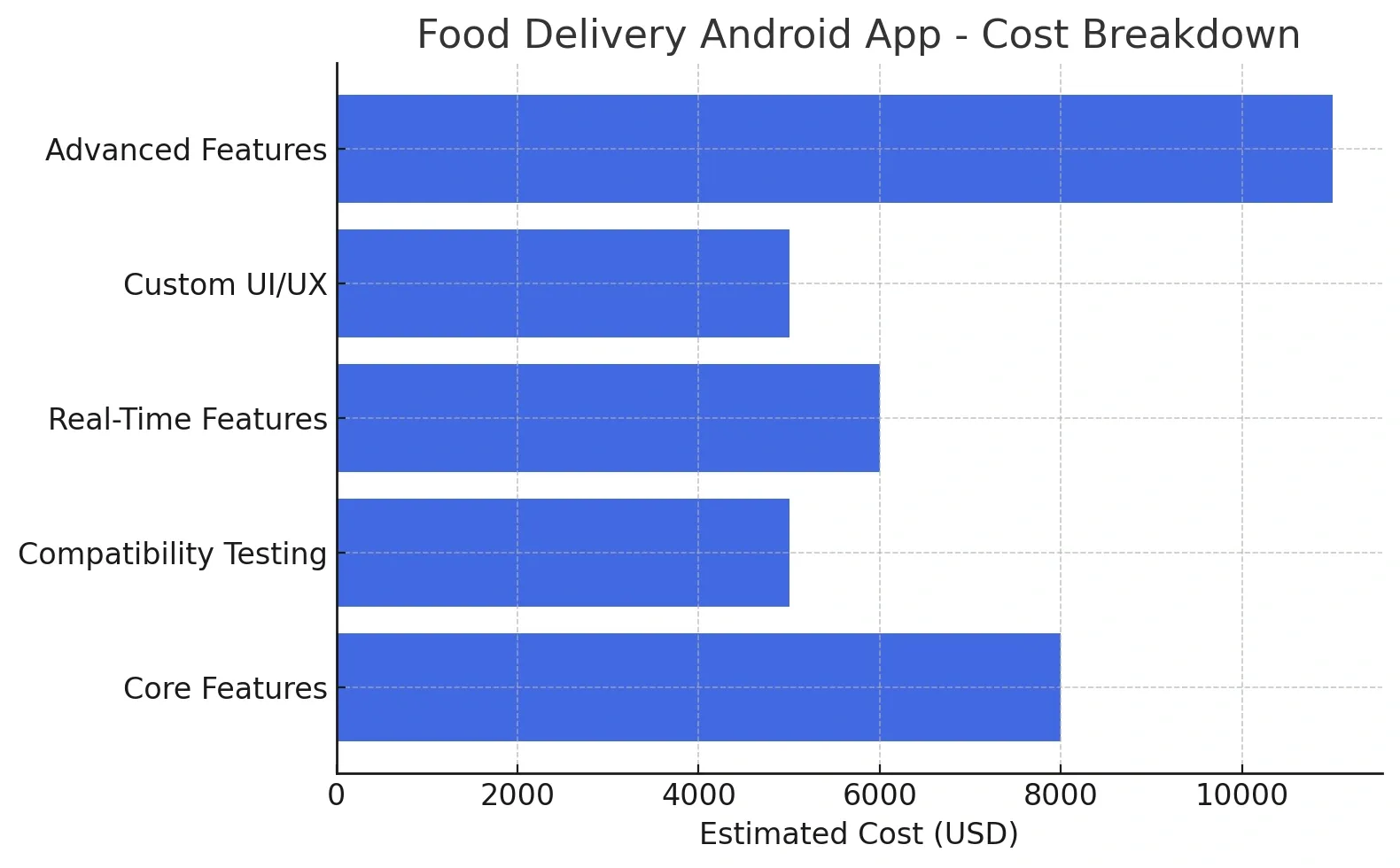
How much does it cost to build a Food Delivery iOS app?
Building an iOS food delivery app in Dubai ranges from $12,000 to $38,000. iOS apps demand strict adherence to Apple’s Human Interface Guidelines and App Store policies. The development process also involves additional steps for Apple Pay integration, device testing across iPhones and iPads, and App Store approval. Apps with rich UI, AI, or personalized features will increase costs.
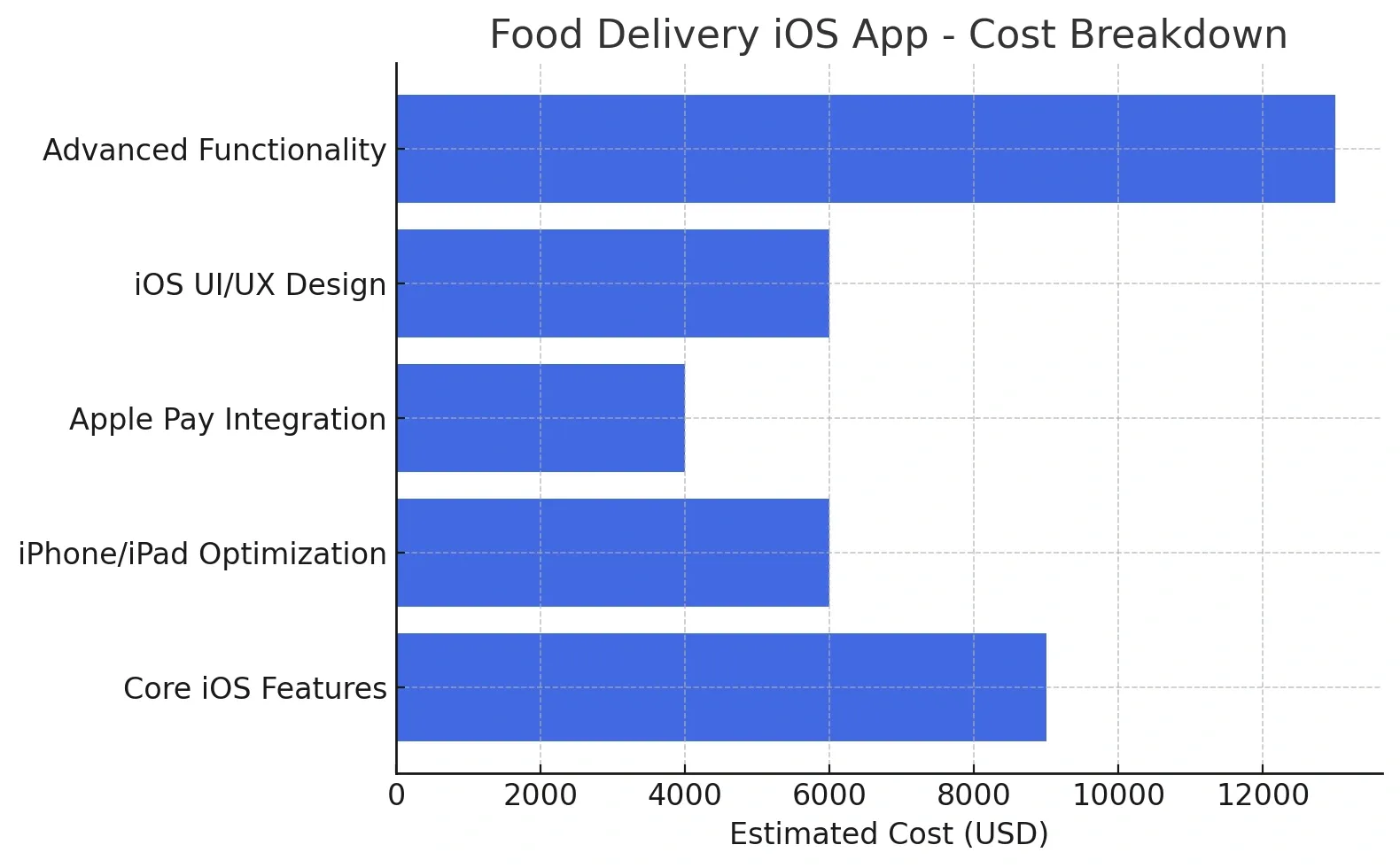
How much does it cost to build a Food Delivery desktop app?
Creating a desktop version of a food delivery platform, usually for admin panels, restaurant dashboards, or analytics, costs between $8,000 and $30,000, based on whether it’s a web-based PWA or native Windows/macOS app. Web apps are more affordable and easier to maintain, while native desktop apps require complex integrations and platform-specific builds.
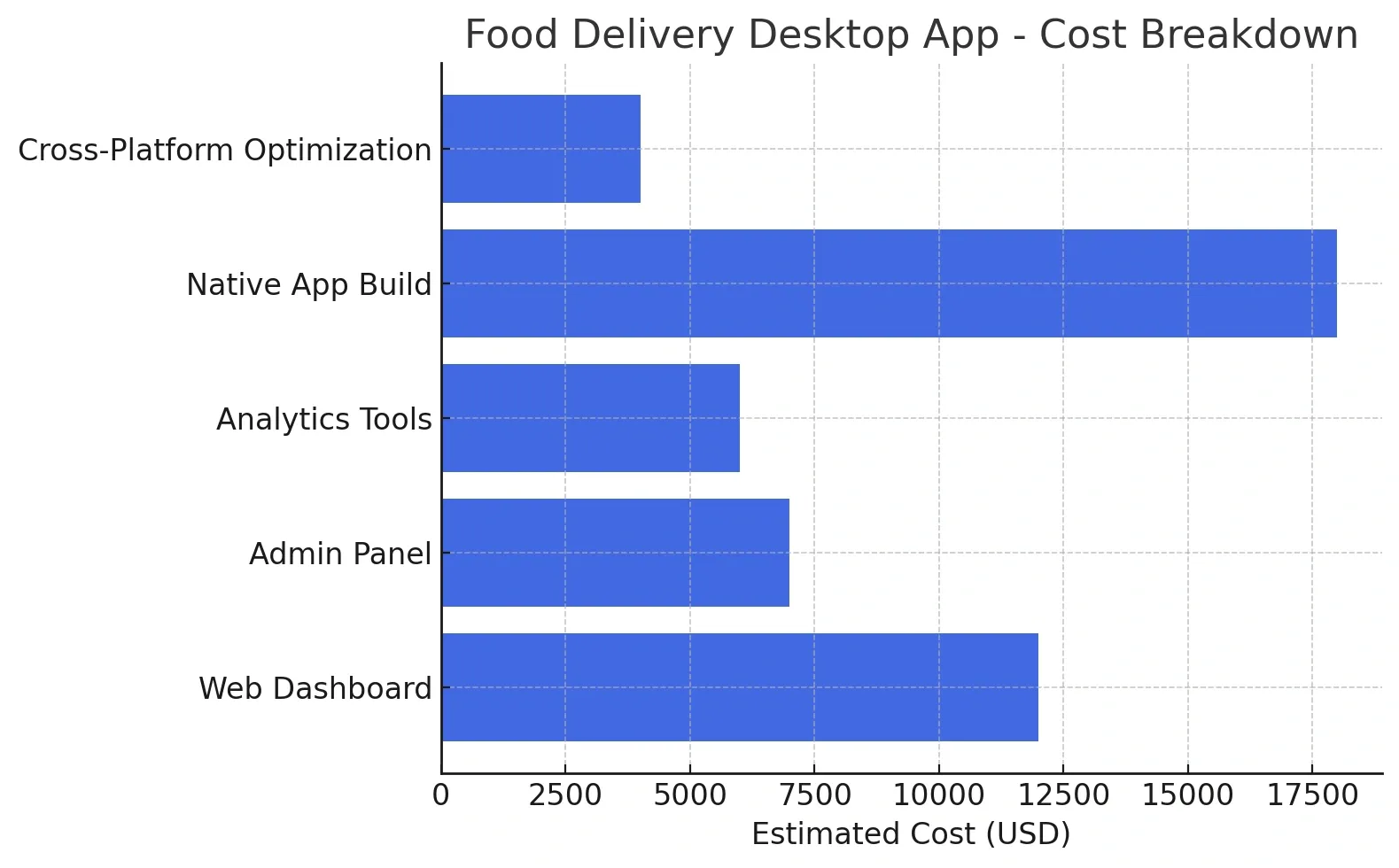
Building a Cross-Platform Food Delivery App: Costs & Benefits
As the food delivery industry continues to surge, building a cross-platform food delivery app has become a strategic option for startups and businesses in Dubai.
It allows you to launch your app on both iOS and Android using a single codebase, saving time and cost without compromising reach.
How much does building a cross-platform food delivery app cost?
The average cost to build a cross-platform food delivery app in 2025 ranges between $18,000 to $45,000, depending on the features, complexity, tech stack, and UI customization.
Key Benefits of Cross-Platform Development
1. Lower Development Cost
You only need one development team and codebase for both iOS and Android, reducing total cost by up to 30%-40% compared to native apps.
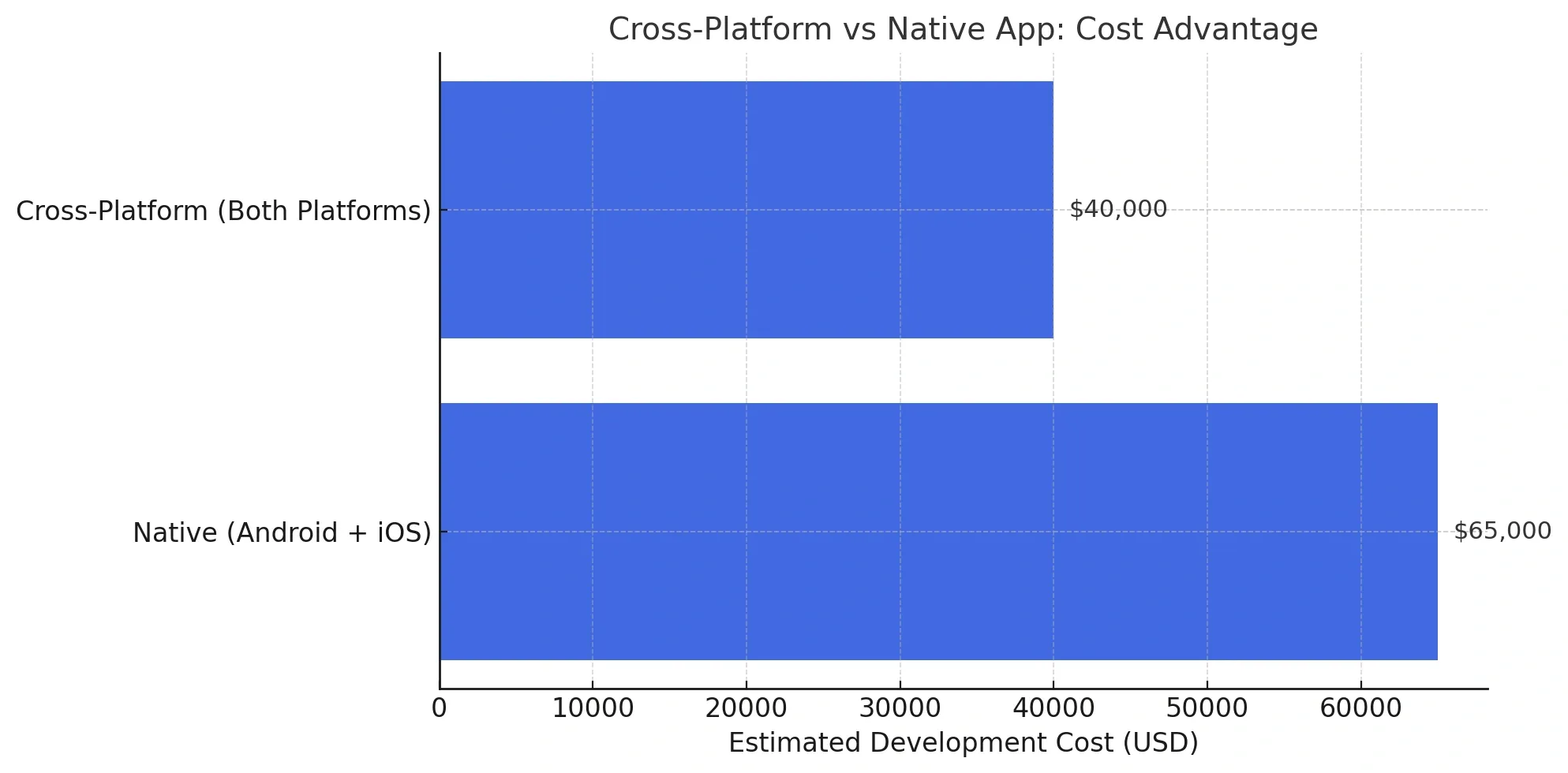
2. Faster Time-to-Market
With unified development and testing, you can launch across platforms simultaneously, cutting delivery time by several weeks.
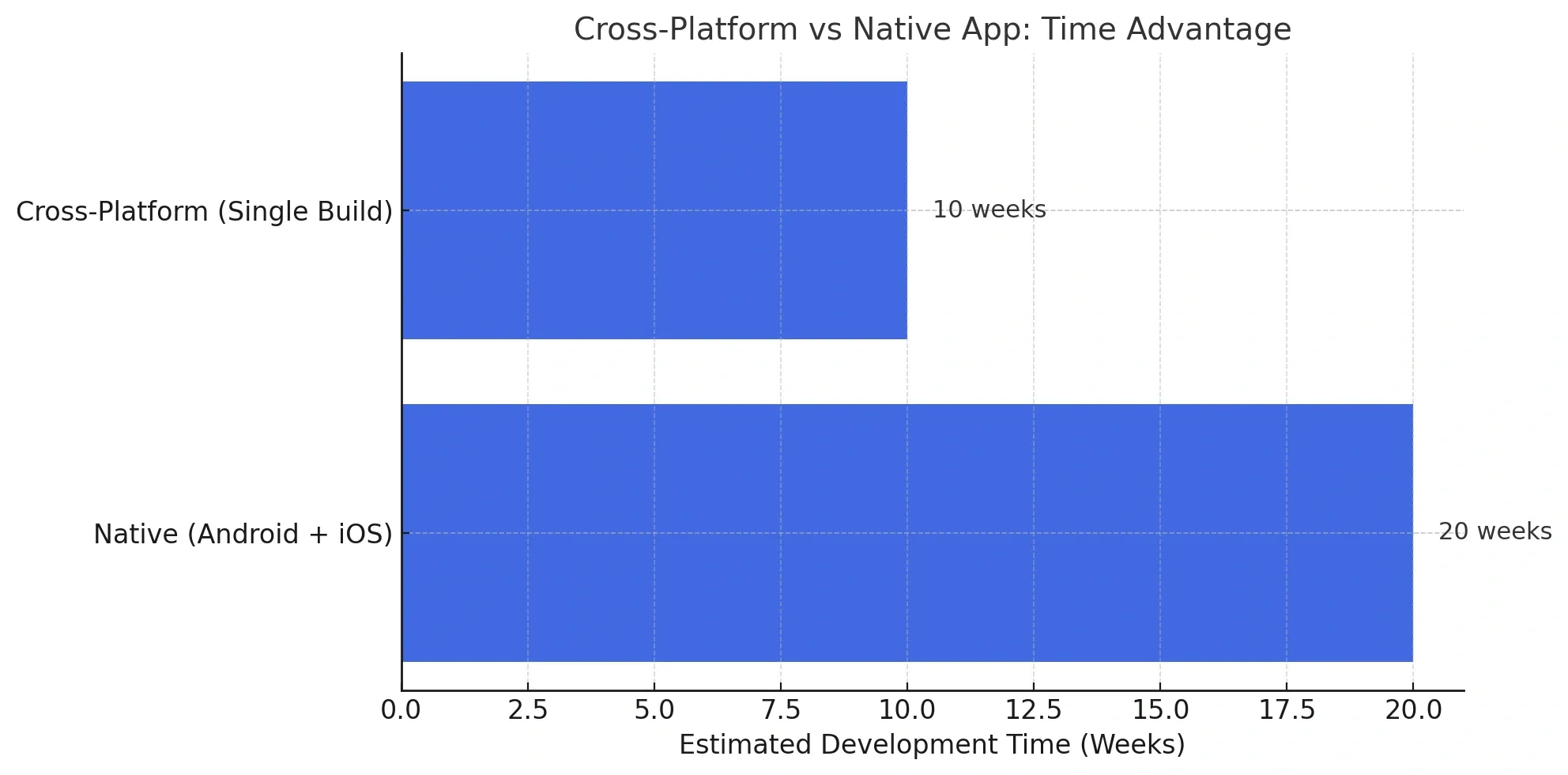
3. Consistent User Experience
Cross-platform frameworks ensure consistent UI/UX across devices and operating systems, with unified branding and interface logic.
4. Easier Maintenance & Updates
Bug fixes and updates can be applied to a single codebase, making post-launch maintenance quicker and more cost-effective.
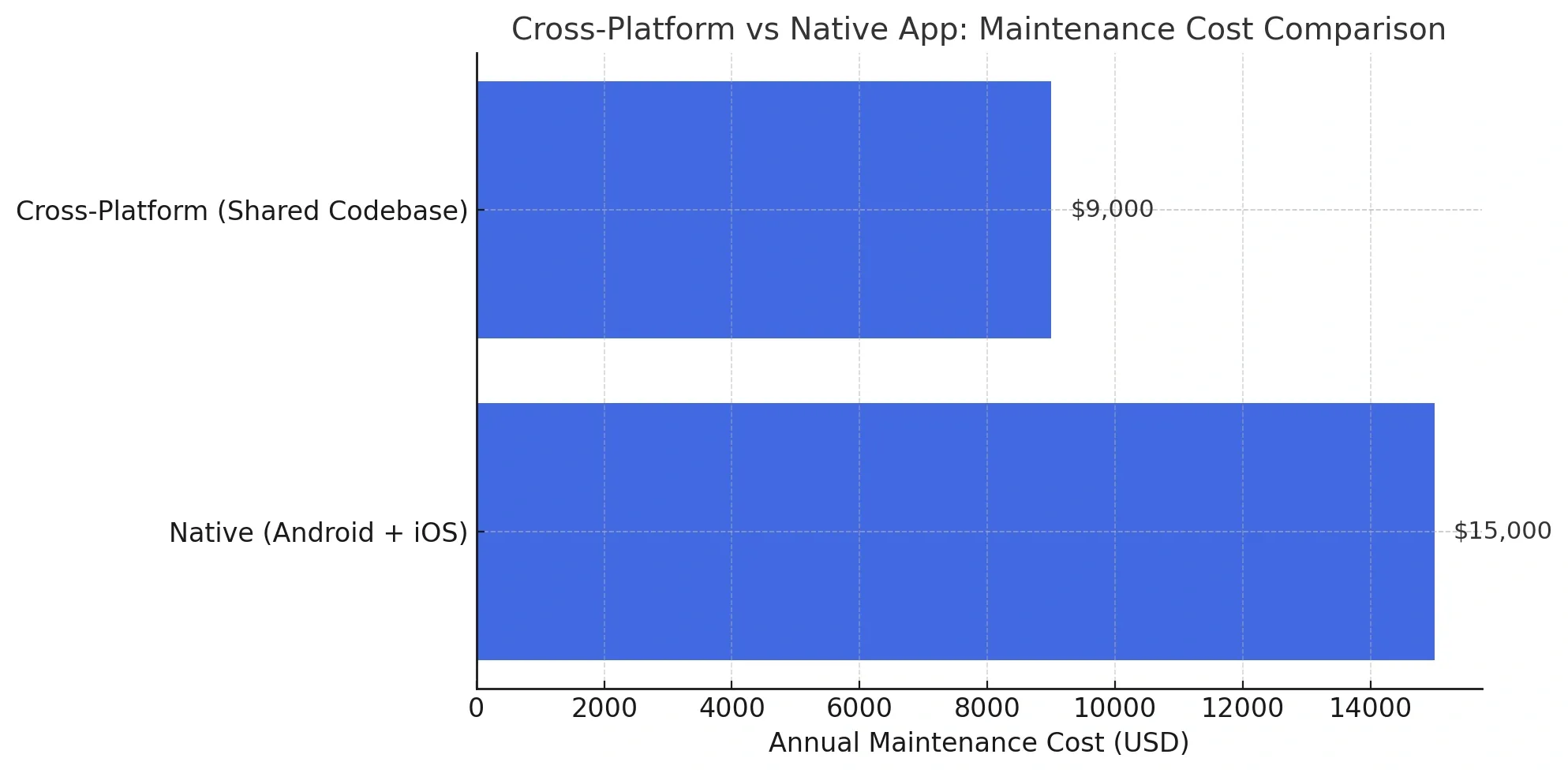
5. Scalability with Plugins
Frameworks like Flutter and React Native support third-party integrations (e.g., Stripe, Firebase, maps) that help you scale features with minimal friction.
Things to Consider
- Performance trade-offs: Cross-platform apps may lag behind native in performance for complex animations or large-scale apps.
- Native integrations: Certain native features (Apple Pay, advanced GPS) may require additional dev time.
- App store compliance: You still need to test and configure for separate app store policies (Google Play vs. App Store).
Is a cross-platform food delivery platform right for you?
If you're launching an MVP, managing a limited budget, or need fast multi-platform coverage, a cross-platform food delivery app is an ideal choice. However, if your app requires extreme performance, high-end animations, or platform-specific features, native development may still be a better fit.
👉 Further resources on app development:
- Healthcare App Development Guide
- How to Make an App Like Uber?
- How Much Does It Cost To Build an Educational App?]
- How to Make an App Like Zomato
- How to Make an App Like TikTok
- How to make an app like Airbnb
Why Dubai Food Tech Startups Choose Tenet for App Development
Dubai’s food tech startups trust Tenet for intuitive UI/UX design, seamless mobile app development, and data-driven digital strategies tailored for the food industry. From real-time ordering and table bookings to loyalty programs and AI-powered CRM systems, we help brands build engaging, high-performance experiences that drive repeat business.
With over 450+ digital solutions delivered, 20 M+ users impacted, and a 98% client satisfaction rate across 15+ countries, Tenet is the go-to partner for scalable food and restaurant digital solutions that elevate customer journeys and boost operational efficiency.
👉 To get a free food app development proposal, contact our experts now.
FAQs
How much does it cost to create an app like Talabat in Dubai
Building a food delivery app like Talabat in Dubai usually costs between $50,000 and $90,000. This includes key features such as real-time GPS tracking, vendor dashboards, multilingual support, and loyalty programs. The final cost depends on app complexity, design depth, and tech stack.
What are the most expensive features in a food delivery app
The most expensive features include real-time order tracking, in-app chat, AI-powered recommendations, loyalty systems, and delivery partner apps. These require complex backend systems, cloud infrastructure, and ongoing data synchronization, which drive up development time and cost.
Can I build a food delivery app in phases to save costs
Yes, building in phases is a common and cost-effective approach. Start with an MVP that includes ordering, payments, and basic UI. Add features like loyalty programs, live tracking, and restaurant dashboards in later phases based on user feedback and growth.
How long does it take to launch a food delivery app in Dubai
A simple MVP food delivery app can be launched in 8 to 12 weeks. For fully featured platforms with tracking, chat, dashboards, and scalability, the timeline extends to 4 to 6 months, depending on your team size and development scope.
What payment gateways are used in UAE-based delivery apps
UAE-based apps often use local gateways like Payit, Telr, and Noon Payments, along with Stripe and Checkout.com. They also integrate with Apple Pay, Google Pay, and support cash on delivery, giving users multiple secure payment options.
Can I integrate multiple restaurants and kitchens into one platform
Yes, modern food delivery apps support multi-vendor setups. Each restaurant or cloud kitchen can manage orders, menus, and reports through a dedicated dashboard. Users see all listings in one app, enabling a seamless ordering experience across vendors.
How much does it cost to build a food delivery app like Careem
Developing a Careem-like food delivery app costs between $60,000 and $100,000. This includes features like delivery scheduling, in-app support, GPS tracking, fleet management, and integration with UAE-specific services like UAE Pass.
How much does it cost to build a food delivery app like Zomato
A Zomato-style app with restaurant discovery, search filters, reviews, menus, and delivery tracking costs between $70,000 and $120,000. Additional features like in-app chat, loyalty points, and analytics tools may increase the cost.
How much does it cost to build a food delivery app like Noon Food
An app like Noon Food typically costs $45,000 to $80,000 to develop. It includes custom branding, real-time ordering, integrated promotions, and compatibility with local wallets or Noon’s broader ecosystem. Final pricing depends on UX, features, and platform coverage.
Need a Custom Food Delivery App? Get a free proposal.
Need a Custom Food Delivery App? Get a free proposal.

Got an idea on your mind?
We’d love to hear about your brand, your visions, current challenges, even if you’re not sure what your next step is.
Let’s talk
